Special Report
42 Mega Cities of the Ancient World
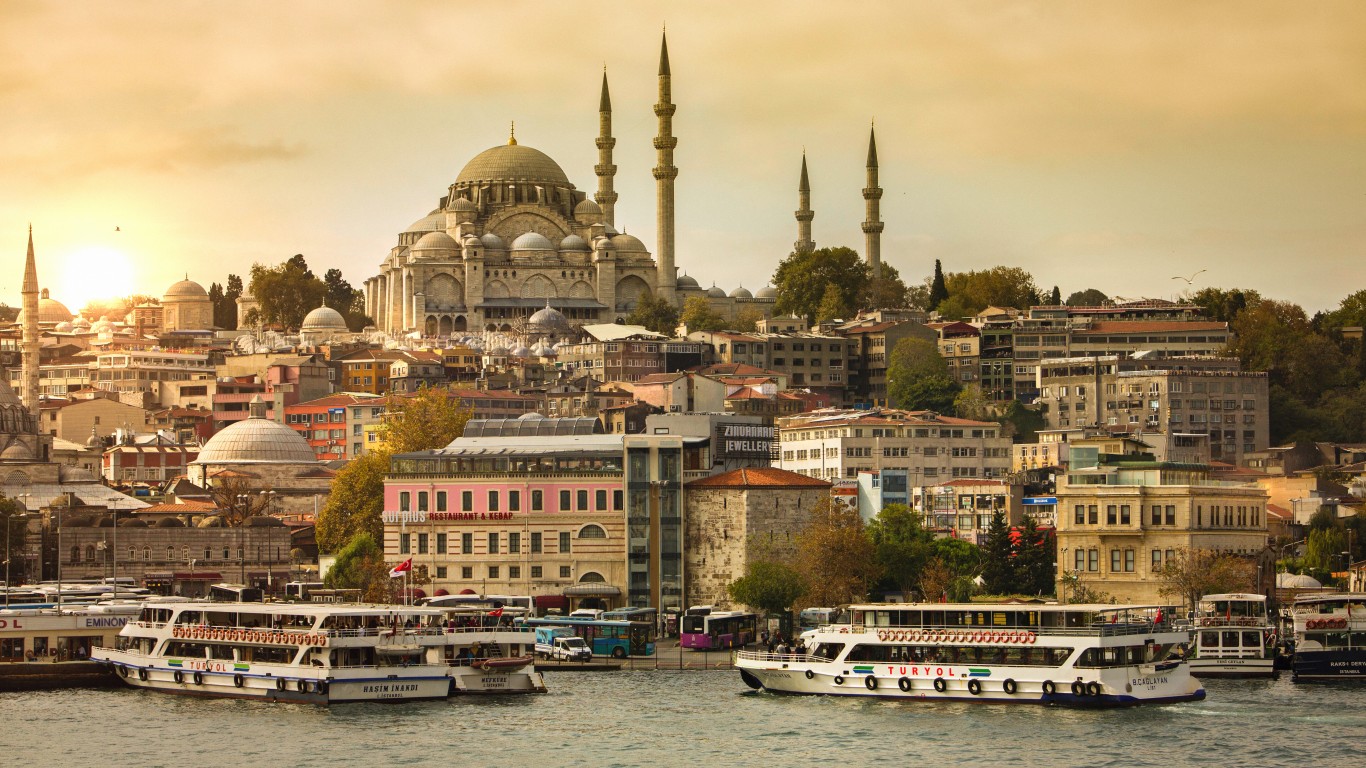
Published:
Last Updated:

Among the most significant developments of the ancient world was the rise of cities. Urbanization is not a new phenomenon, and though many of today’s metropolitan areas have populations in the tens of millions, some of the cities of the past were surprisingly large.
From the 19th century, when pioneering archaeologist Heinrich Schliemann found the ruins of Troy in Turkey, to British archaeologist Howard Carter’s discovery of King Tutankhamun’s tomb in 1922, the ancient world has become a popular fascination. Thebes, Ur, Babylon, Xi’an, and Samarkand are just some of the legendary names from antiquity that bring out the Indiana Jones in us.
Archaeology has brought the ancients closer to us. It has been quick to embrace technology, such as carbon dating, to detail the stories from antiquity. Because of progress in geophysics, soil chemistry, satellite imaging, three-dimensional mapping skills, drones, software for ground-penetrating radar, and remote sensing, we have a better grasp of the complexity and sophistication of these ancient civilizations.
A recently published study has enabled us to understand the size and scope of the major cities of the ancient world. “Historical Urban Population, 3700 BC – AD 2000” was originally developed by the Yale School of Forestry & Environmental Studies and is the first spatially explicit global data set containing location and size of urban populations over the last 6,000 years. Using data from the report, 24/7 Wall St. has created a list of the 42 largest cities in ancient times.
Click here to see the 42 mega cities of the ancient world.
Click here to read our detailed findings and methodology.
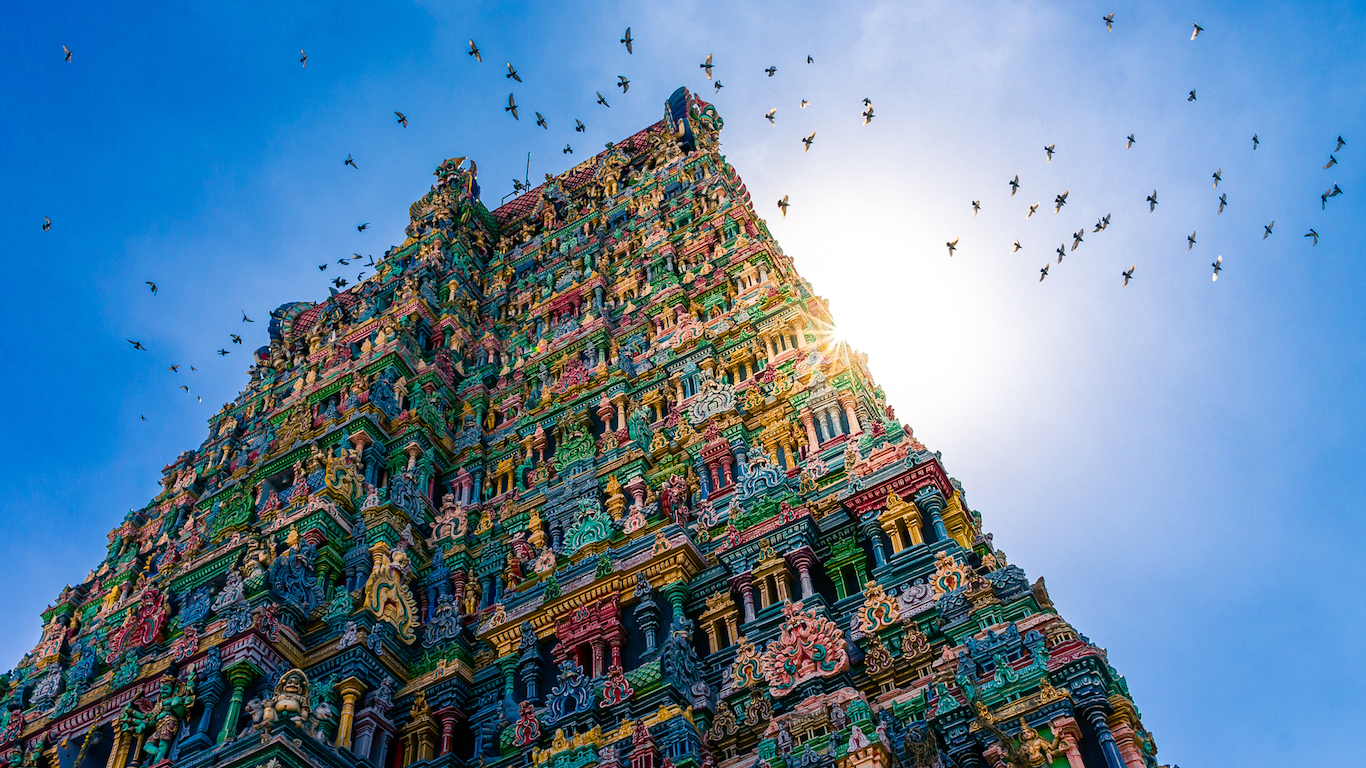
42. Madurai
> Peak population: 100,000
> Peak population year(s): A.D. 500, A.D. 600
> Location: 9.9° 78.1°, present day India
Madurai is located in the south-central portion of the Indian subcontinent, near the Vaigai River, in the Indian state of Tamil Nadu. In the ancient era, Madurai was ruled by the Pandya kings, Tamil rulers who were known to Greek and Roman civilizations. Madurai became famous for its hand-loom weaving of silks and cottons. The old section of the city, which is enclosed by three hills, features the Minakshi-Sundareshvara temple, a colorful, maze-like structure. In the 1940s, the city was the center for the civil disobedience movement against British colonial rule.
[in-text-ad]
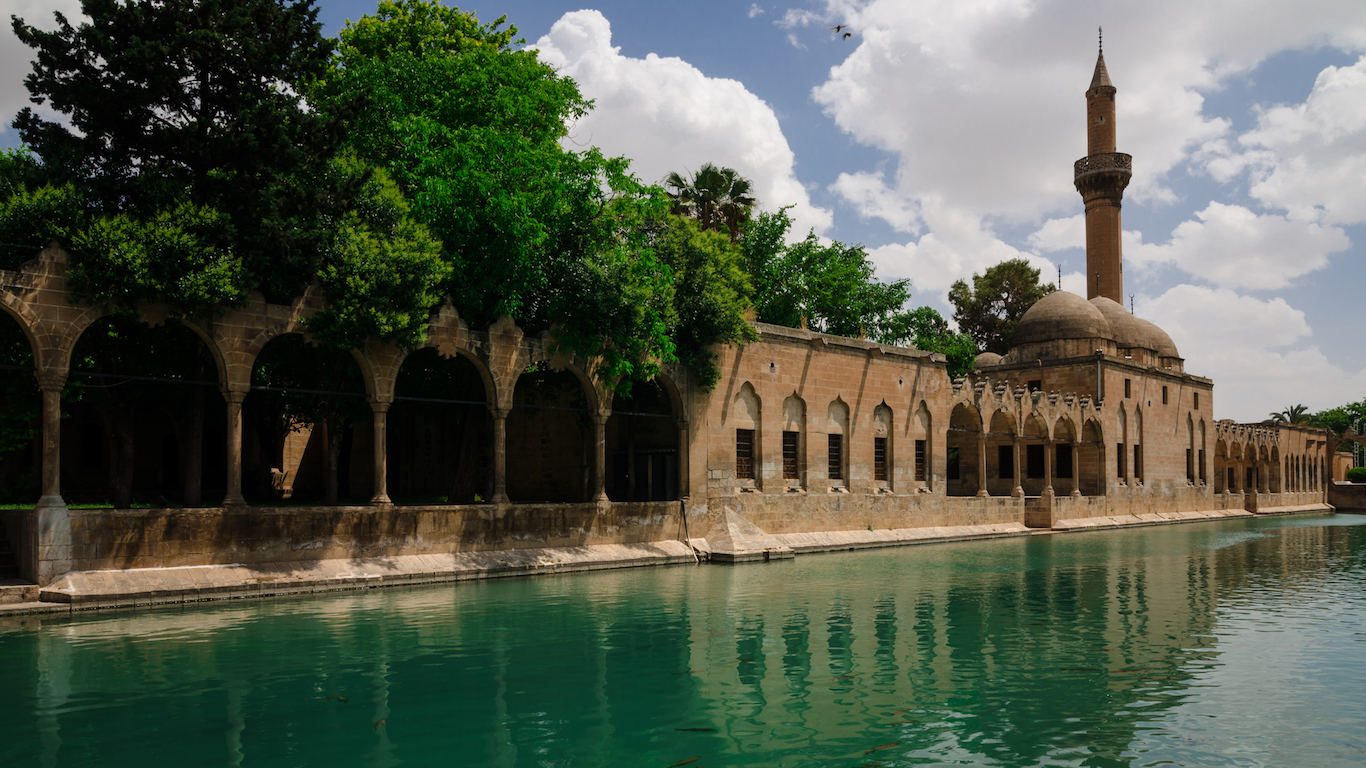
41. Edessa
> Peak population: 100,000
> Peak population year(s): A.D. 500
> Location 37.2° 38.8°, present day Turkey
Edessa is known as Urfa or Sanliurfa in modern times and is located in southeastern Turkey, near the Syrian border. The city became a strategically important place in antiquity because it controls a pass to the south where a road connected lower Macedonia on the coast with the north, and the Adriatic Sea with the Aegean Sea. Edessa was a post on the ancient Roman highway the Via Egnatia.
Edessa got its name from Macedonian soldiers who occupied the city during the Hellenistic era and named it Edessa after a city in Macedonia. The city was fought over between Crusaders and Muslims in medieval times, and it was eventually annexed by the Ottoman Empire in the 16th century.
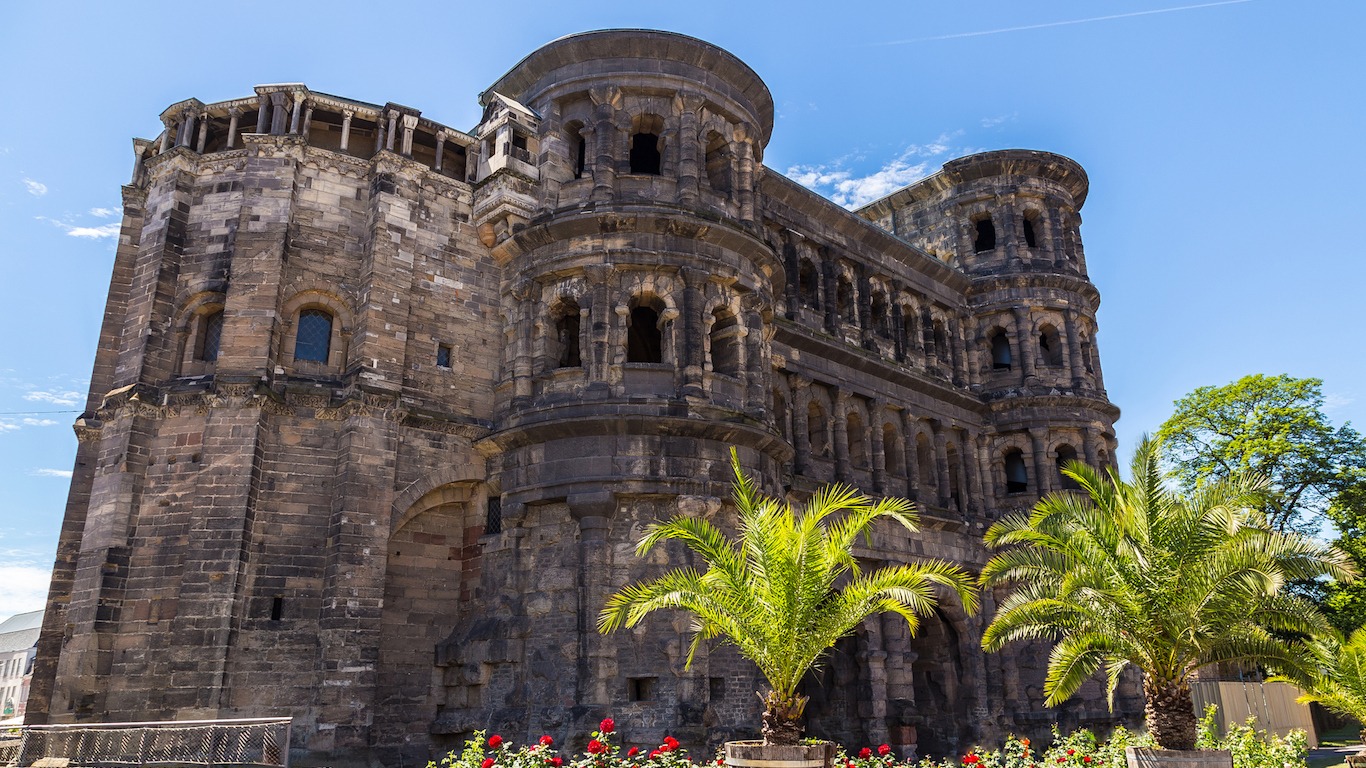
40. Trier
> Peak population: 100,000
> Peak population year(s): A.D. 300
> Location 49.8° 6.6°, present day Germany
Trier, as it is known today, was also called Trevers. It is the oldest city in Germany and is situated near the border with Luxembourg near the picturesque Mosel Valley. Trier was founded by the Roman emperor Augustus in 15 B.C. and was frequented by Roman emperors. Emperor Constantine made the city the capital in the latter years of the Roman Empire. Among the Roman sights that survive today are baths, an amphitheater, and a fortified city gate called the Porta Nigra.

39. Nicomedia
> Peak population: 100,000
> Peak population year(s): A.D. 300
> Location 40.8° 29.9°, present day Turkey
Nicomedia is the ancient name for Izmit, which is located about 62 miles east of present-day Istanbul. In modern times, Izmit is prominent because of its position on the main road connecting Istanbul with the Turkish capital of Ankara. There has been a city at this location since at least the eighth century B.C. Its greatest period as the city of Nicomedia was during the third century B.C., when it was built by Nicomedes I of Bithynia. During the Roman occupation, Nicomedia was a residence of emperors, and it became the eastern capital of the Roman Empire under Diocletian. The Ottomans conquered the city in 1326.
[in-text-ad-2]
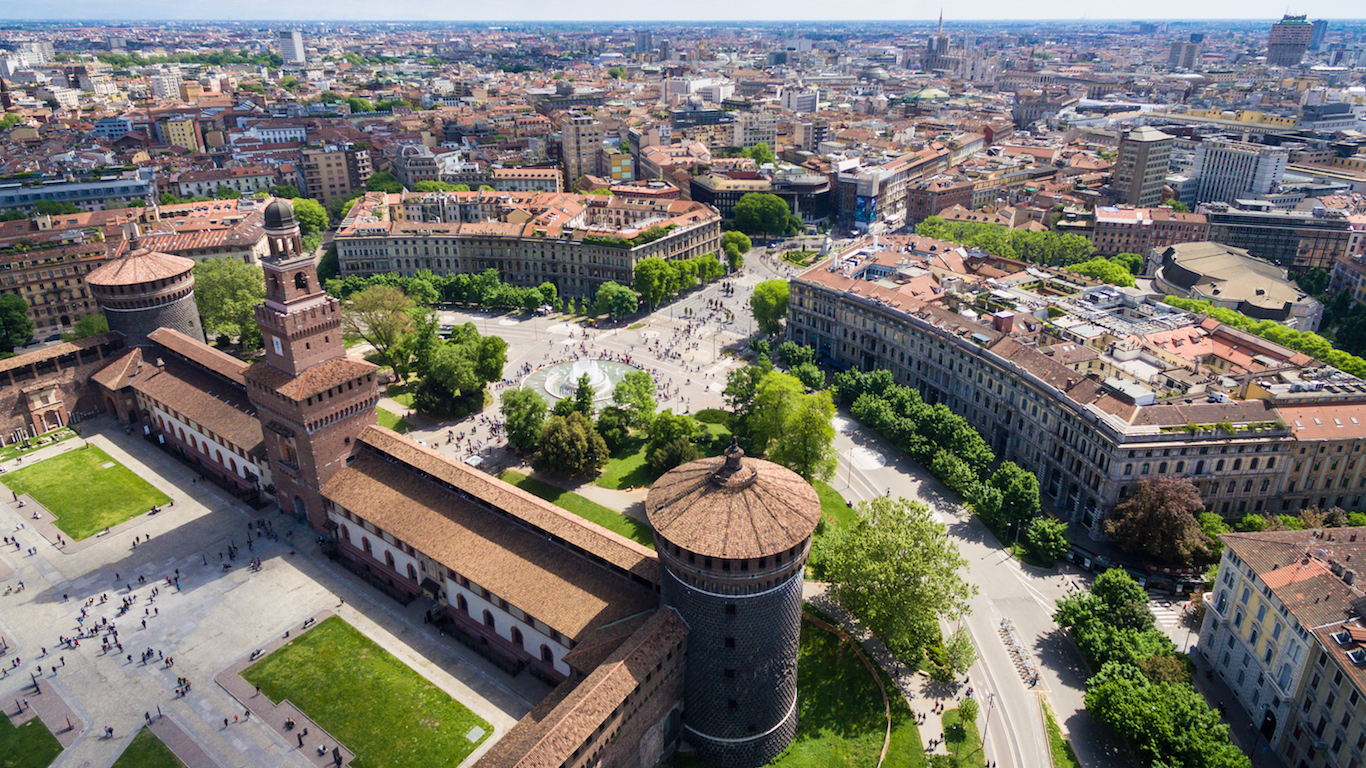
38. Milan
> Peak population: 100,000
> Peak population year(s): A.D. 300
> Location 45.5° 9.2°, present day Italy
Milan became a significant city on the Italian peninsula in ancient times because of its geographic position in the northern part of Italy. The Roman Empire conquered the city in 222 B.C. and it would eventually become the capital of the Western Roman Empire.
Milan became one of the engines of economic growth in northern Italy in the 19th and 20th centuries. Today, the city, with a population of about 1.3 million people, is known as one of the fashion capitals of the world.
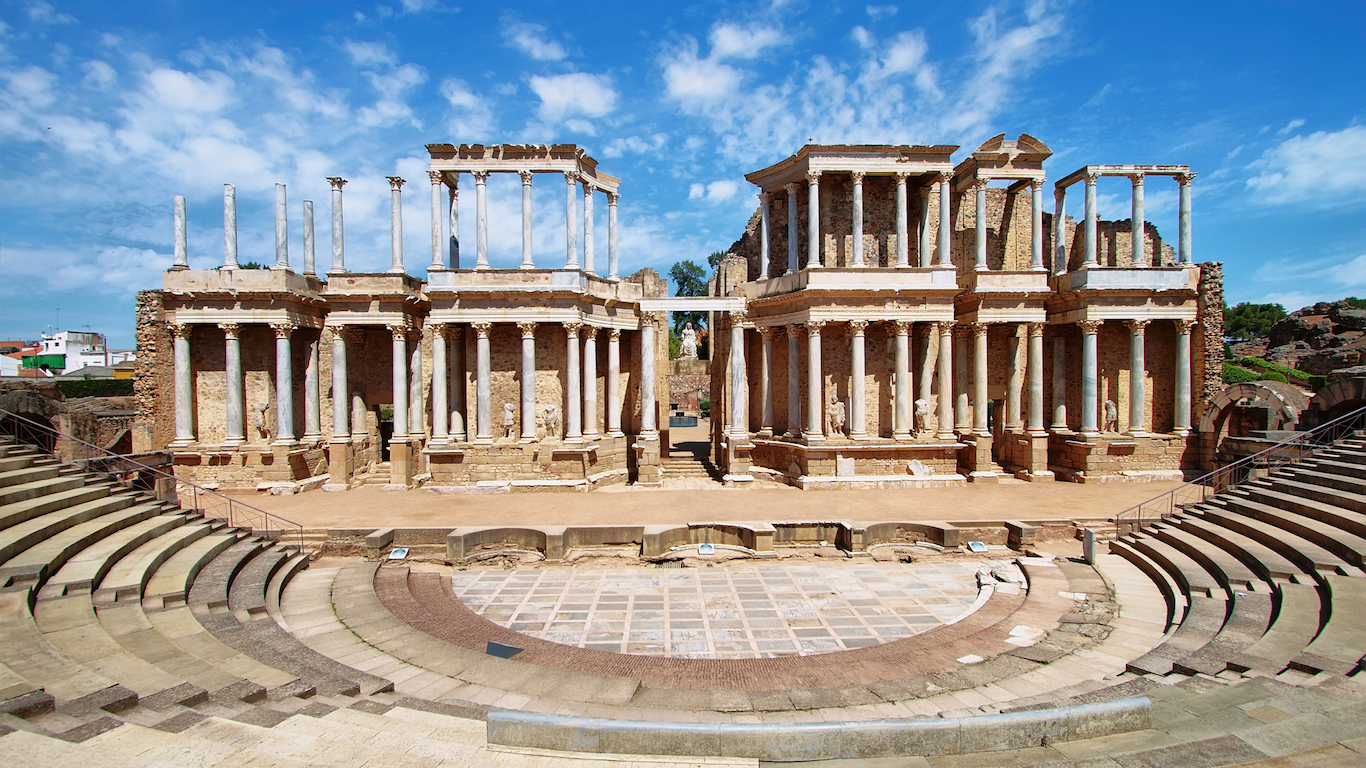
37. Merida
> Peak population: 100,000
> Peak population year(s): A.D. 300, A.D. 400
> Location 38.9° -6.3°, present day Spain
Merida is a city in southwestern Spain, and in ancient times it was known as Emerita. The Roman Empire extended to this part of what is now Spain, and a Roman bridge built during the reign of Augustus still spans the Guadiana River near Merida. The city was big enough to accommodate a garrison of 90,000 soldiers. There is plenty of other evidence of Roman influence in Merida, including an amphitheater, an arch, and a temple to the goddess Diana. The archaeological locations were named UNESCO World Heritage sites in 1993.
[in-text-ad]
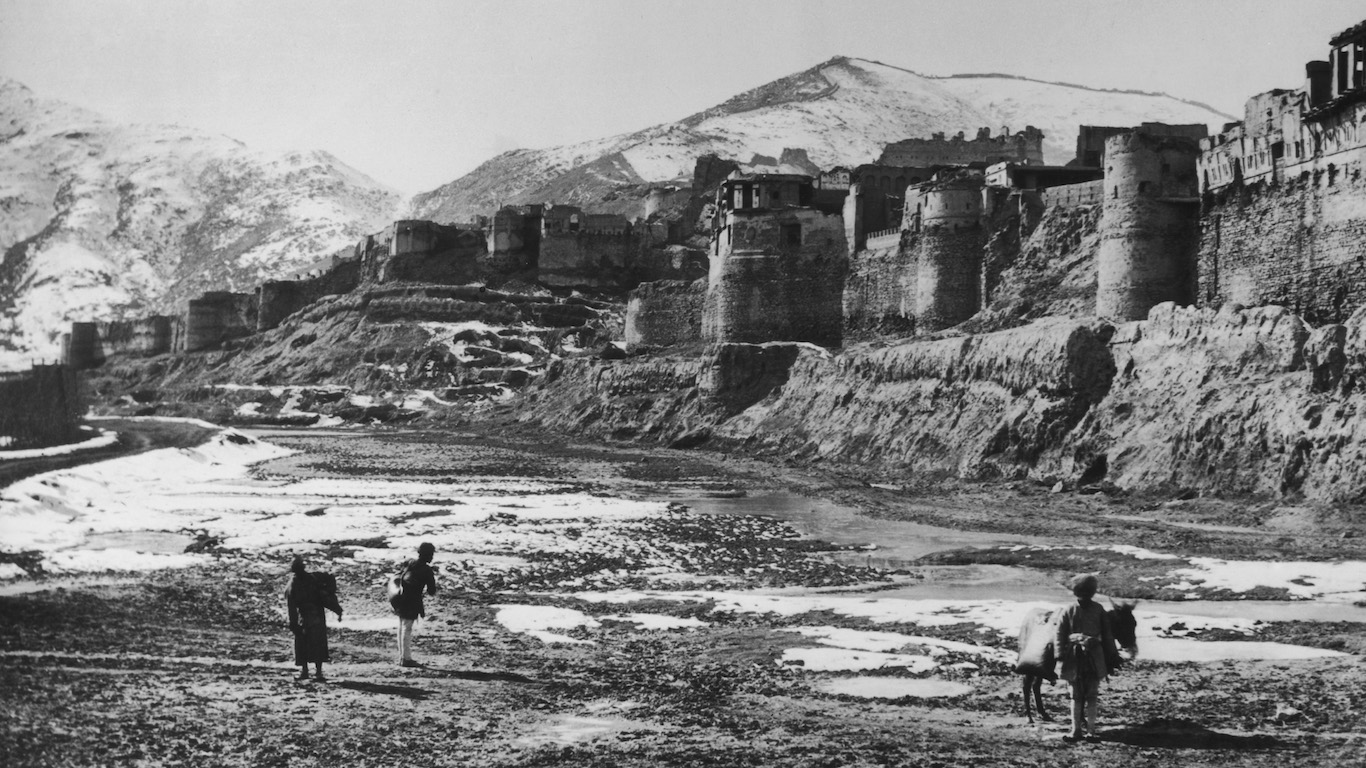
36. Peshawar
> Peak population: 100,000
> Peak population year(s): A.D. 1, A.D. 100, A.D. 200
> Location 37.7° 62.2°, present day Turkmenistan
Peshawar, whose name means “frontier town,” is located in northern Pakistan, near the legendary Khyber Pass and just east of the border of Afghanistan. In the ancient era, the city was the capital of the Buddhist kingdom of Gandhara, known variously as Parasawara and Purushapura. Because of its proximity to the Khyber Pass, the city developed into a nexus of trade with Afghanistan and central Asia. Peshawar’s historic buildings include a fort built by the Sikhs and a Buddhist monastery that later became a Hindu temple.
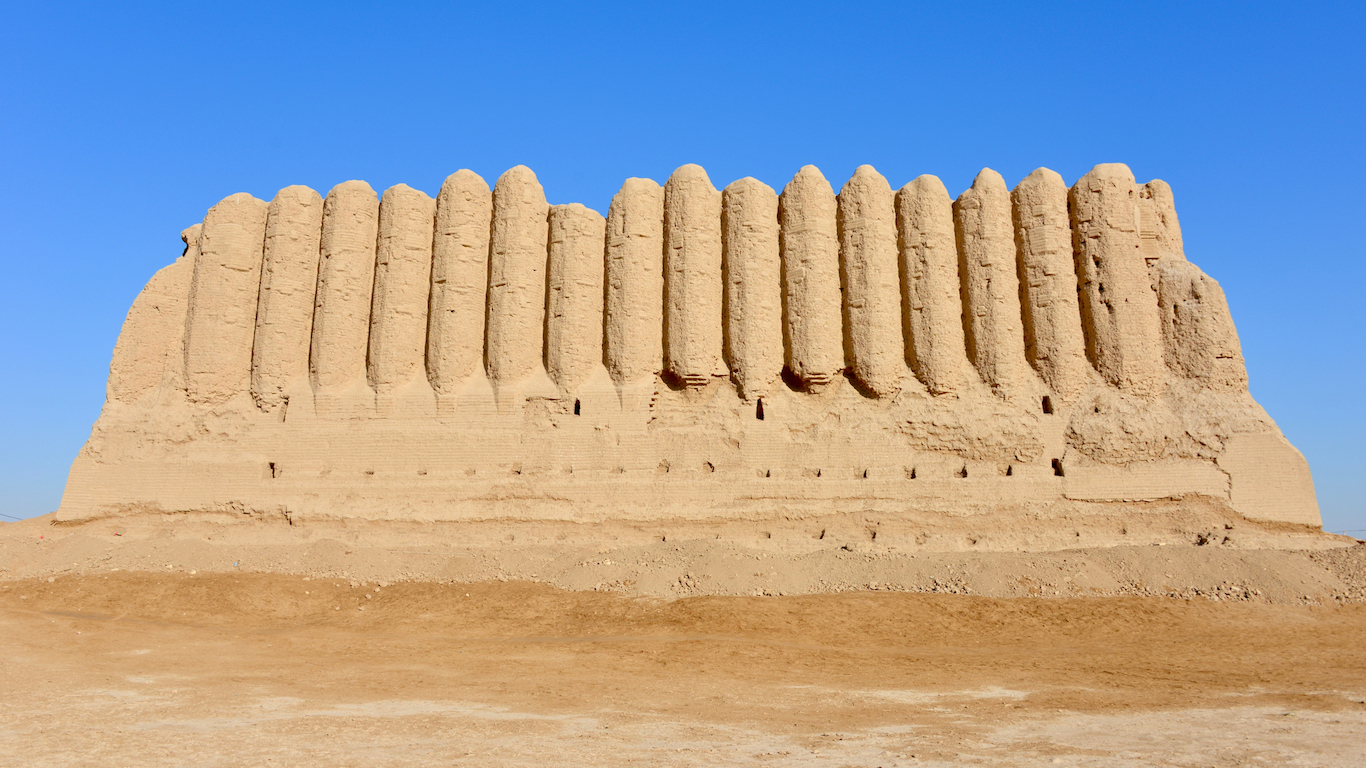
35. Merv
> Peak population: 100,000
> Peak population year(s): A.D. 1, A.D. 100, A.D. 300-500
> Location 37.36° 62.06°, present day Turkmenistan
The ancient city of Merv existed where the city of Mary in Turkmenistan is located today. In the year 1150 — after the period reviewed for this list — Merv was the largest city in the world with a population estimated at 200,000. Merv was mentioned in ancient Persian texts and was a prominent city in the Persian Achaemenid Empire. Merv prospered largely because of its position near the Silk Road in central Asia. The city served as a major center for Islamic learning and flourished until Genghis Khan’s army sacked it in the 13th century and killed 700,000. Its importance declined further as the trade routes were bypassed by seagoing commerce. Today, Merv’s urban past can be seen in the ruins along the Silk Road.
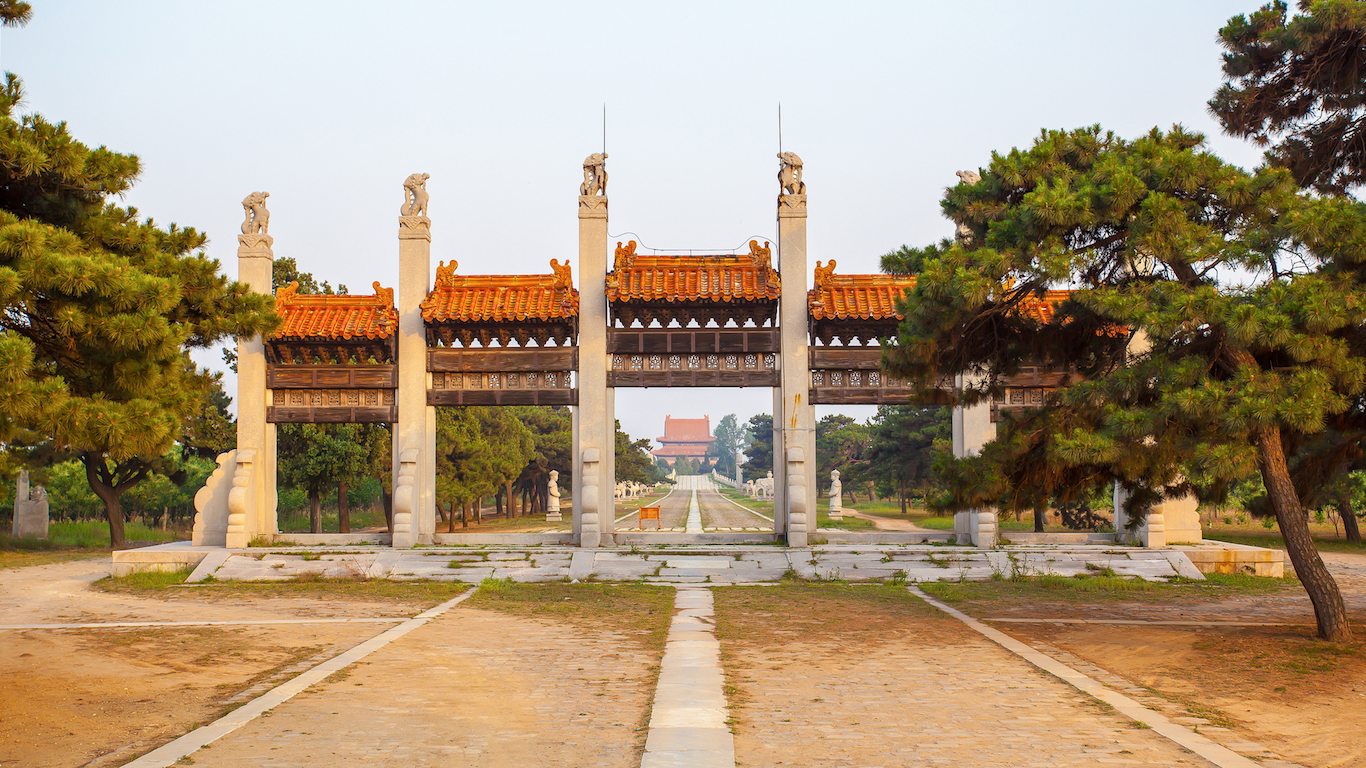
34. Xianyang
> Peak population: 100,000
> Peak population year(s): 300 B.C., 200 B.C.
> Location 34.4° 108.7°, present day China
Xianyang, one of 13 Chinese cities on this list, is situated on the Wei River a few miles rom the provincial capital of Xi’an in central China. It has a population of more than 5 million people. Xianyang was the seat of the Qin Dynasty and served as the capital for 13 dynasties. Twenty-seven emperors are entombed in Xianyang. Among them, at the Qian Mausoleum, is Empress Wu Zetian, the only female monarch in Chinese history.
[in-text-ad-2]
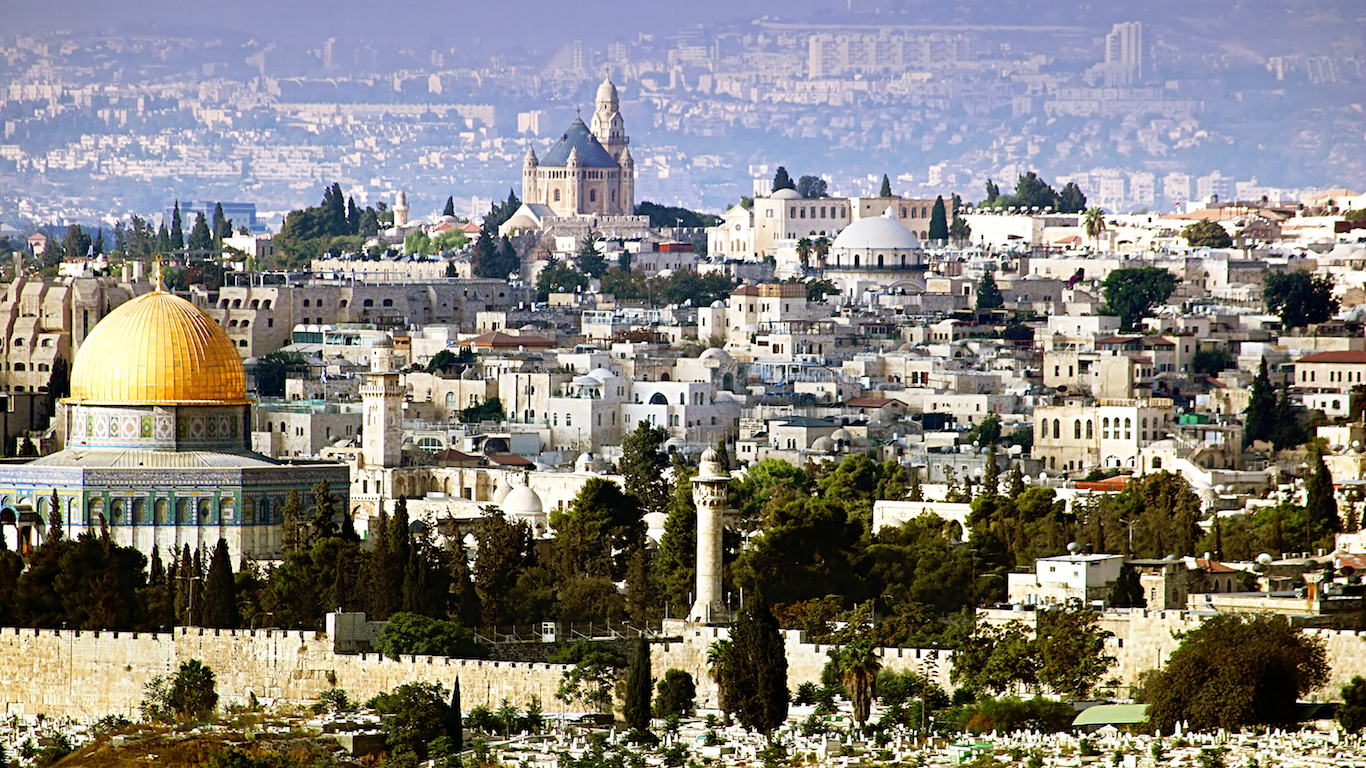
33. Jerusalem
> Peak population: 100,000
> Peak population year(s): 300 B.C.
> Location 31.8° 35.2°, present day Israel
First settled in 3500 B.C., Jerusalem is one of the world’s oldest cities. In the ancient world, it was consistently one of the largest. From about 300 B.C. through A.D. 600, Jerusalem’s estimated population hovered at 100,000. While surpassed during the centuries leading up to the common era by the likes of Carthage, Alexandria, and Rome — each with populations between 250,000 and 500,000 — it was always one of the world’s largest cities in ancient times.
Because of its significance in the texts of the world’s largest monotheistic religions Judaism, Islam, and Christianity, violent conflicts have been waged over the holy city for thousands of years.
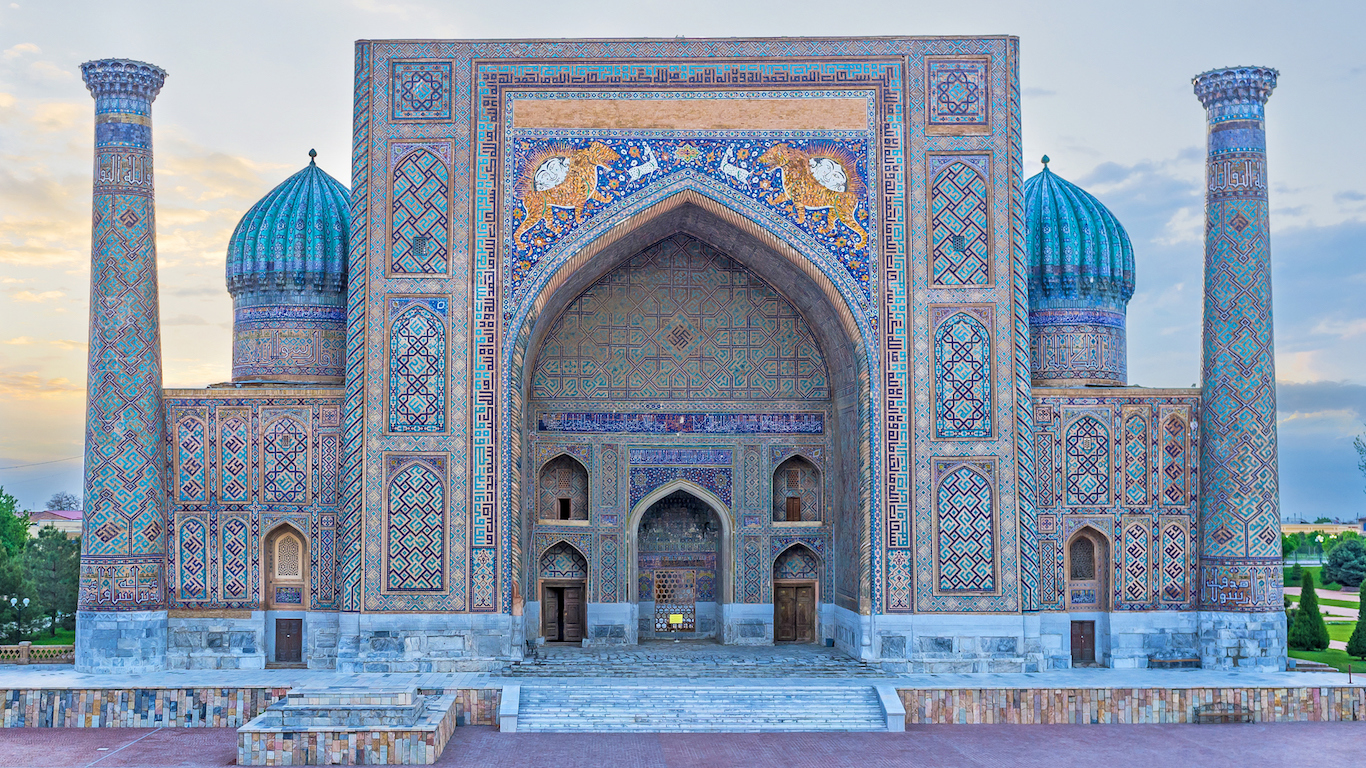
32. Samarkand
> Peak population: 100,000
> Peak population year(s): 400 B.C., 300 B.C.
> Location 39.7° 66.9°, present day Uzbekistan
The famed city of Samarkand, known in ancient times as Sumargand, was an important stop on the storied Silk Road trading route. The city, now a UNESCO World Heritage site, dates back to the seventh century B.C. It reached its zenith in the 14th and 15th centuries during the Timurid era, when Tamerlane made it his capital. Given its geographic significance, the city was conquered many times, including by Alexander the Great in the fourth century B.C. and by the Mongols under Genghis Khan in the 13th century. Later conquests led to the decline of the city, which did not recover until the late 19th century, when the introduction of the railroad led to its rebirth as a trading center.
[in-text-ad]
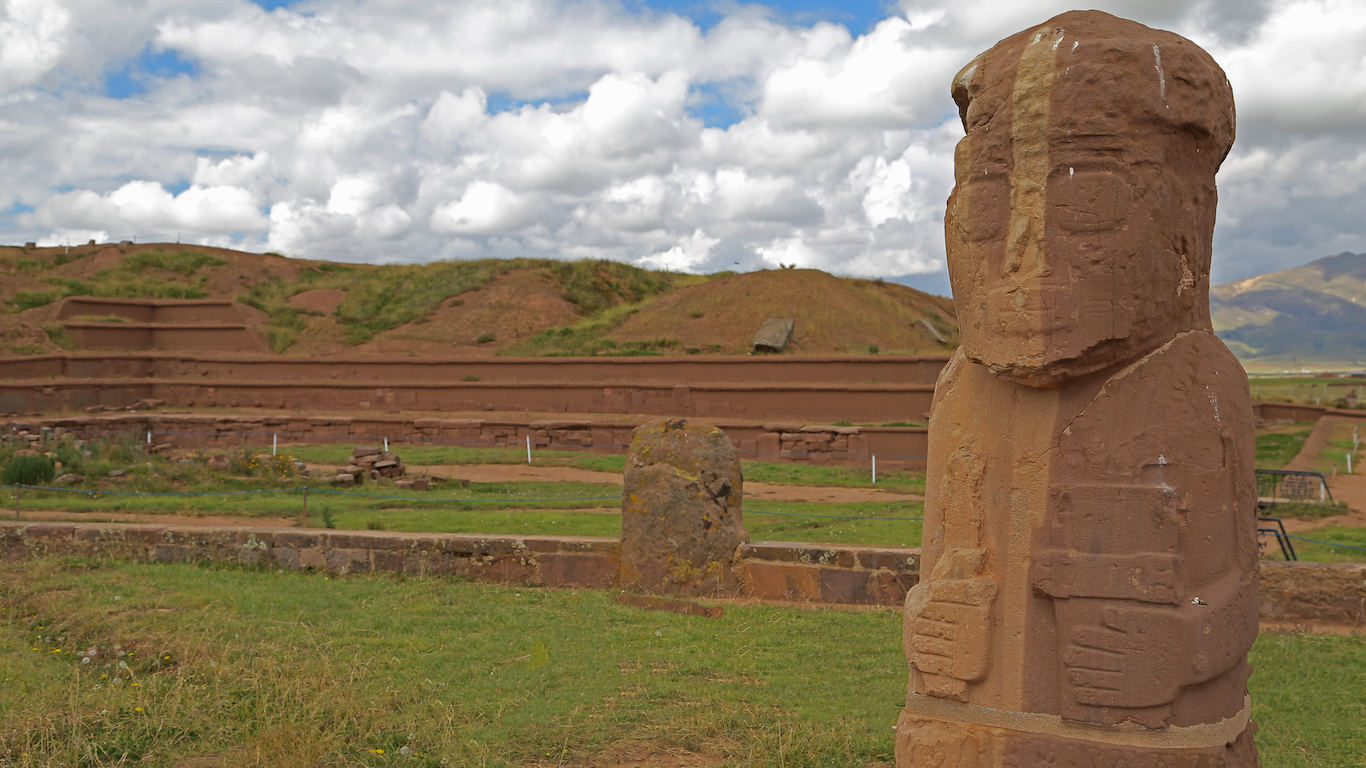
31. Tiahuanaco
> Peak population: 100,000
> Peak population year(s): 500 B.C.
> Location -16.6° -68.7°, present day Bolivia
Tiahuanaco is located in present-day Bolivia, about 44 miles west of the capital La Paz. It is one of the best examples of pre-Columbian civilization in South America. The ancient city continues to reveal its past. Three years ago, archaeologists from the Tiahuanaco Archeological Research Center unearthed an underground pyramid at the site of the ancient city — known in the older time as Tiwanaku — by using ground-penetrating radar. The site of the ancient city, a UNESCO World Heritage site since 2000, contains monuments that may have deteriorated because of weathering.
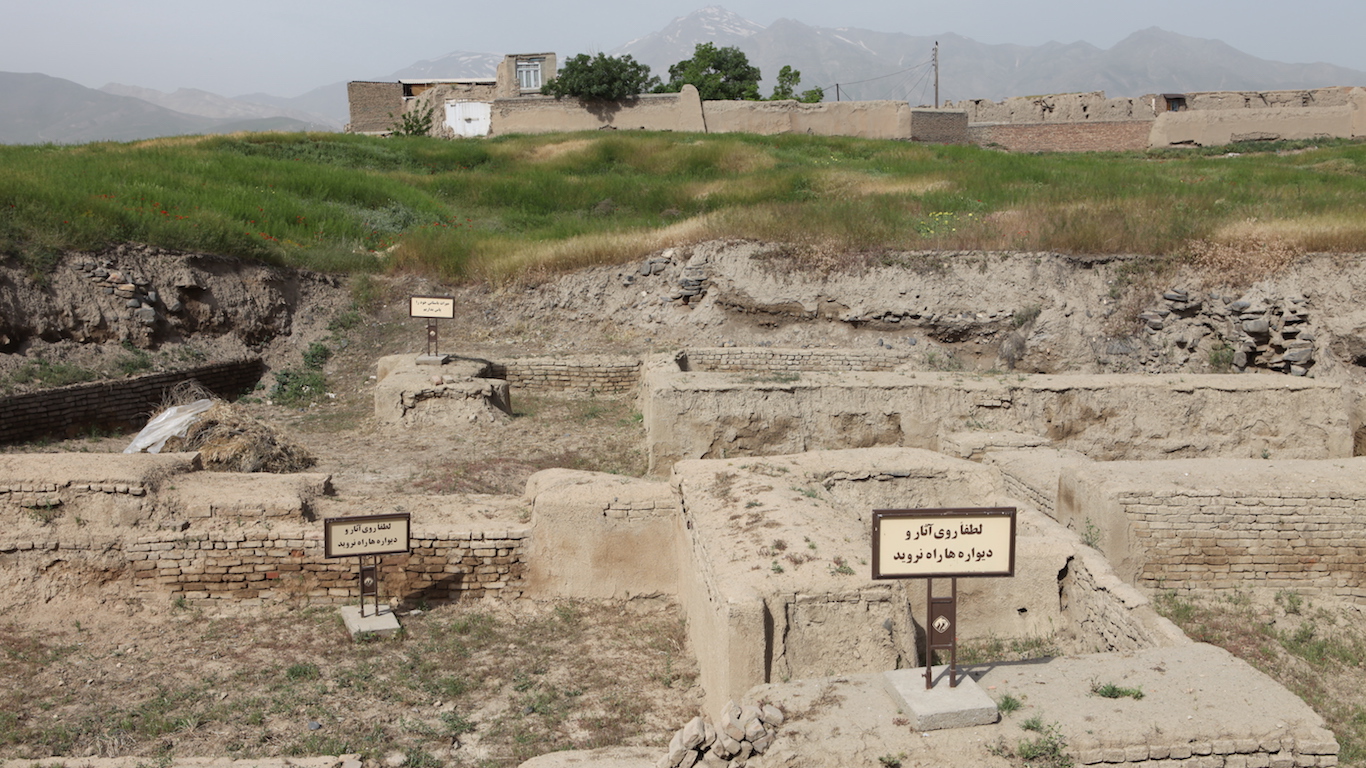
30. Ecbatana
> Peak population: 100,000
> Peak population year(s): 500 B.C., 400 B.C.
> Location 34.8° 48.5°, present day Iran
In 678 B.C., Indo-Iranian tribe the Medes established its capital city of Ecbatana in present day Hamadan, Iran. According to Greek writers such as the historian Herodotus, Ecbatana in the fifth century B.C. was surrounded by seven concentric walls.
The city became a major population and political center for the region until its was conquered in 550 B.C. by Persian king Cyrus the Great. Cyrus later founded and ruled a vast empire comprising the Near East from the Aegean Sea to the Indus River. As part of the empire, Ecbatana became the summer residence of the Achaemenian kings.

29. Tikal
> Peak population: 100,000
> Peak population year(s): 900-800 B.C., 600 B.C., A.D. 400-500
> Location17.2° -89.6°, present day Guatemala
The ruins of the ancient Mayan city Tikal are now part of Guatemala’s Tikal National Forest, which UNESCO designated a World Heritage site for its biodiversity and archeological significance. Tikal was a major center of Mayan civilization for more than 1,000 years.
Based on data from the report “Historical Urban Population: 3700 BC-AD 2000,” the population of the city was approximately 100,000 from the years 900 B.C. through A.D. 500.
[in-text-ad-2]
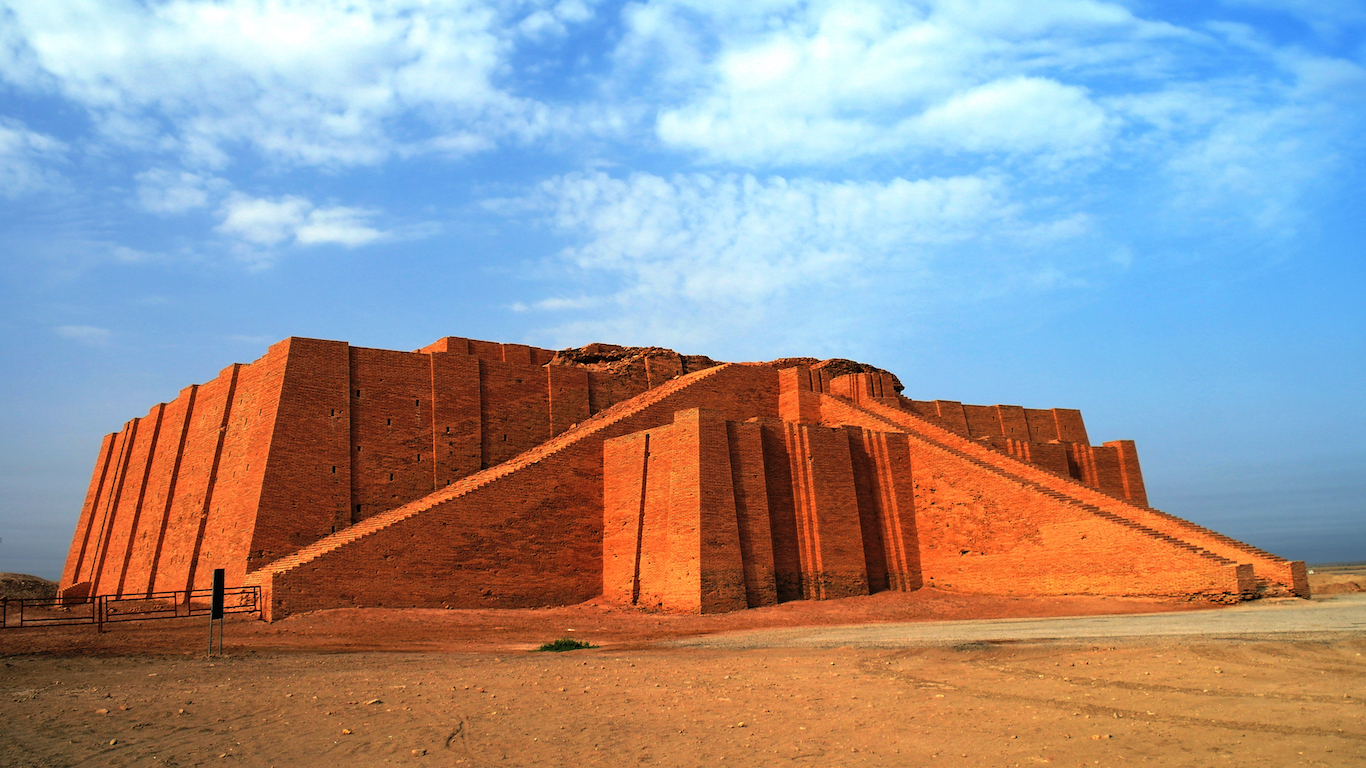
28. Ur
> Peak population: 100,000
> Peak population year(s): 2100 B.C.
> Location 31.0° 46.1°, present day Iraq
Ur was one of the most famous cities in ancient times, whose history goes back to 4000 B.C. Ur owes its significance to its location where the Tigris and Euphrates rivers pour into the Persian Gulf. In biblical tradition, Abraham was from Ur of the Chaldees, and many scholars believe Ur to be the place mentioned in the bible. Ur flourished until about 450 B.C. and declined in importance as the Persian Gulf receded south because of the silting of the land by flooding of the rivers and overuse of the land. Of the 17 cities with population estimates for the year 2100 B.C. from the report “Historical Urban Population: 3700 BC-AD 2000,” Ur was the largest city in the world at the time with 100,000.

27. Suzhou
> Peak population: 120,000
> Peak population year(s): A.D. 600.
> Location 31.3° 120.6°, present day China
Suzhou, known as Soochow by local residents in ancient times, has been known for generations for attracting artists and scholars and for its graceful gardens. Ironically, a city known for its classic gardens was born out of violence. Suzhou was a planned capital, constructed in the sixth century B.C. by King Helu, who assassinated his cousin to take the crown and make war with his neighbors. The city completed the construction of the Grand Canal in A.D. 618, leading to a sustained period of prosperity that made it one of the wealthiest and most sophisticated cities in the world. Suzhou’s importance lasted until it was overtaken by neighboring Shanghai.
[in-text-ad]
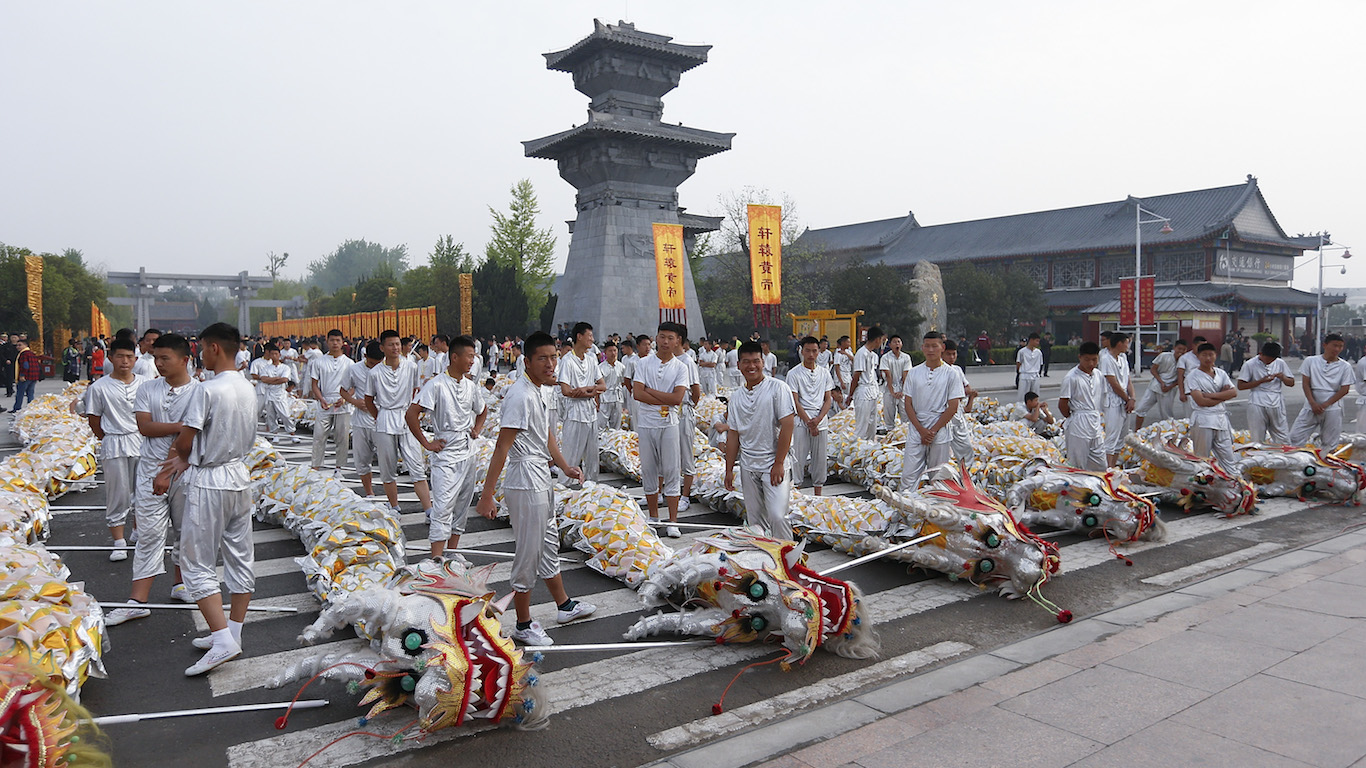
26. Xinzheng
> Peak population: 120,000
> Peak population year(s): 300 B.C.
> Location 34.2° 113.4°, present day China
Xinzheng, capital of Henan Province in the northeastern part of the country, is the reputed birthplace of Xuanyuan Huangdi, the Yellow Emperor. The Chinese believe they are descended from Xuanyuan Huangdi, who was first ruler of what would eventually become China. His reign began in 2697 B.C., when he united the tribes of the Yellow River area. Xinzheng is where Chinese culture originated, so this city holds a special place in the world’s most populous country. The city also is known for its profusion of date trees, which are a colorful sight when the fruit ripens in the fall.
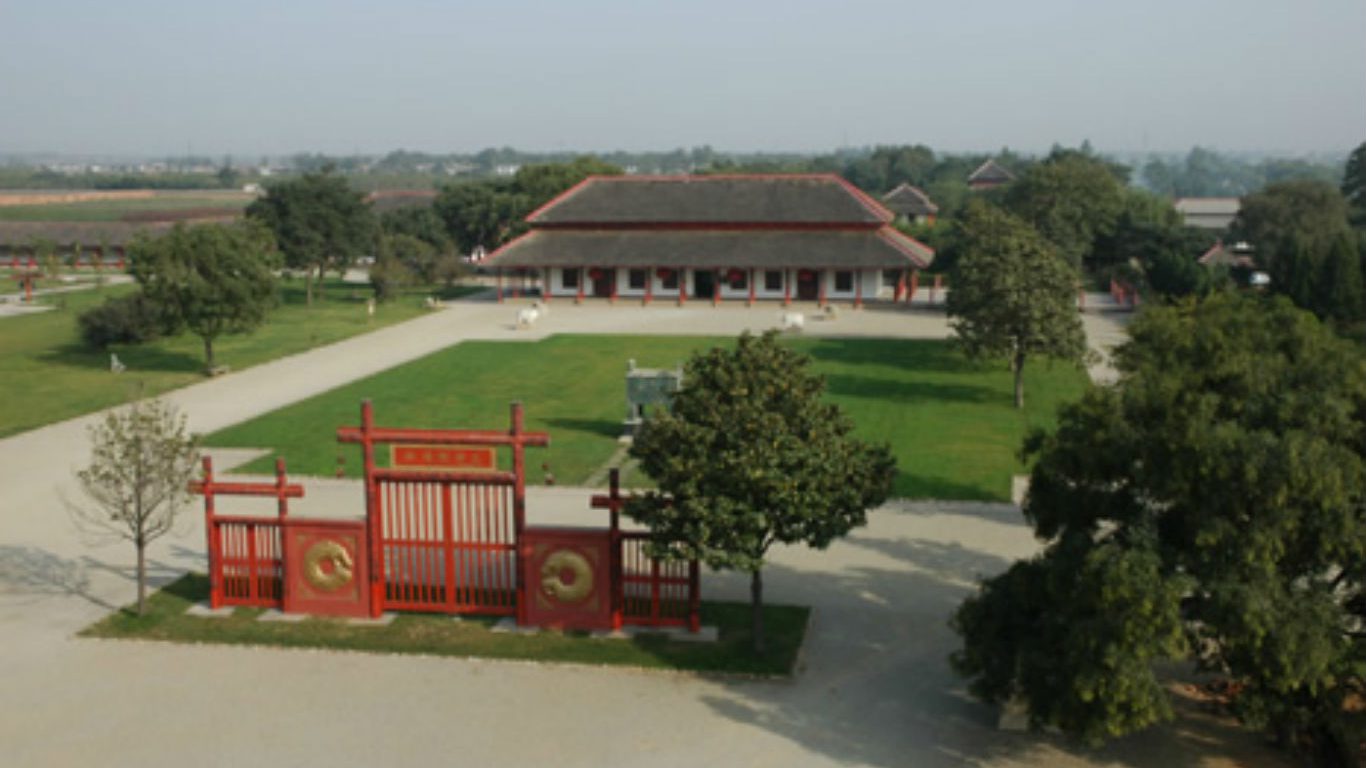
25. Yin
> Peak population: 120,000
> Peak population year(s): 1300 B.C., 1200 B.C.
> Location 36.1° 114.3°, present day China
The Chinese Bronze Age city of Yin — known also as Yin Xu — was the capital city of the late Shang Dynasty, which from the year 1300 B.C. through approximately 1046 B.C. marks the start of Chinese recorded history. Inscribed artifacts discovered at the ruins are considered the earliest example of Chinese characters in existence.
Of the 16 cities with population estimates for the year 1300 B.C. from the report “Historical Urban Population: 3700 BC-AD 2000,” Yin was the largest city in the world at that time, followed by Thebes, Egypt.
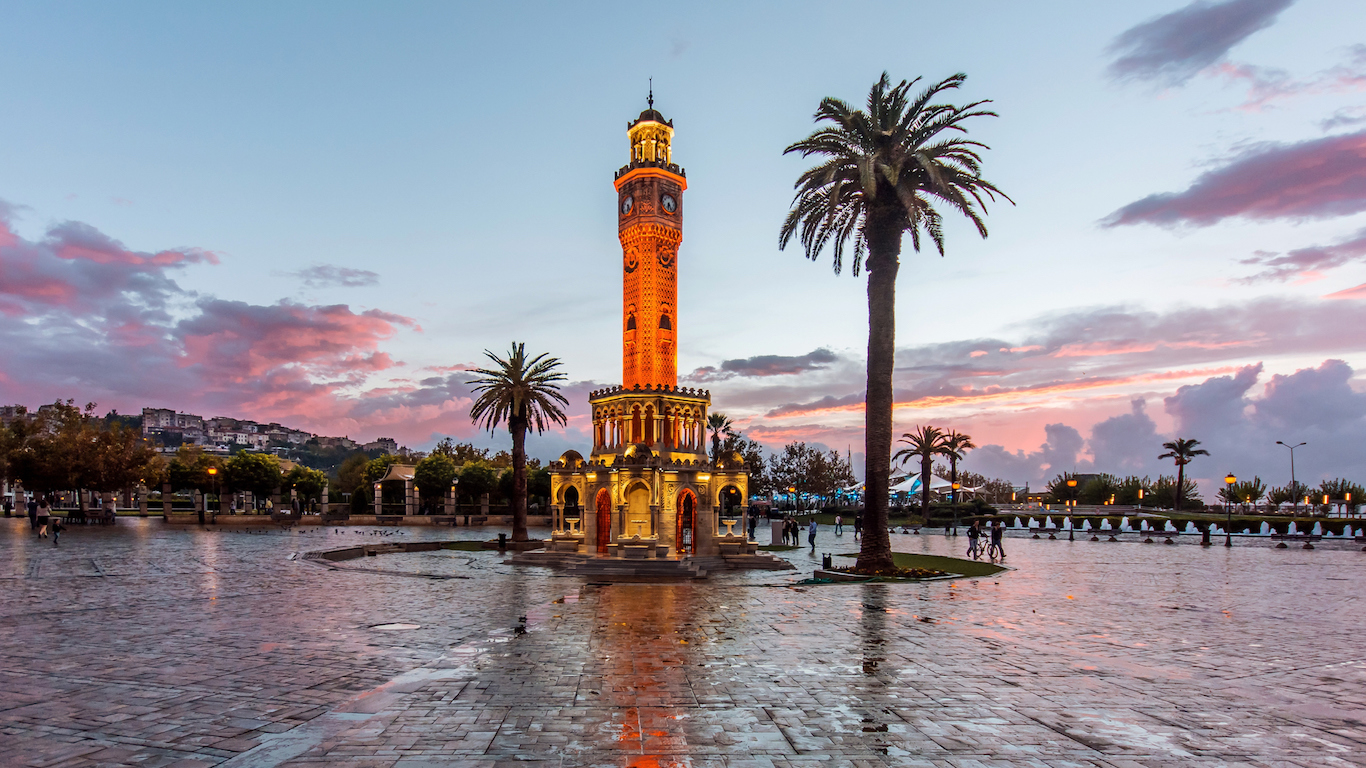
24. Smyrna
> Peak population: 125,000
> Peak population year(s): A.D. 100
> Location 38.4° 27.1°, present day Turkey
Smyrna, known today as Izmir, is located on the western coast of Turkey, directly across the Aegean Sea from Athens, Greece. The city was founded in 3000 B.C. and became a Greek settlement, and it may have been visited by Homer. The ruins of agora, the center of the city’s artistic, commercial, and political life, are the most important remains of the ancient city. Smyrna would eventually be eclipsed in importance by Constantinople, what is now Istanbul.
[in-text-ad-2]
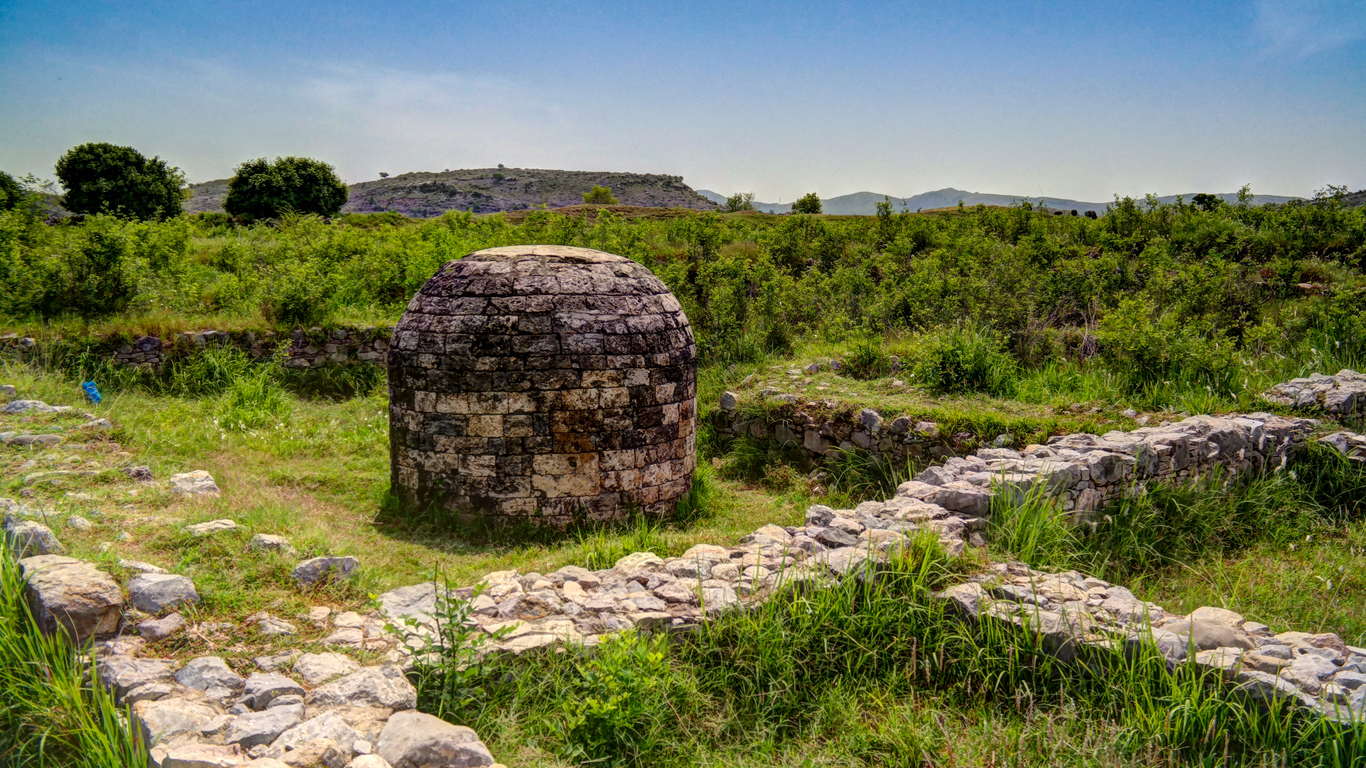
23. Taxila
> Peak population: 150,000
> Peak population year(s): 200 B.C., 100 B.C., A.D. 100
> Location 33.8° 72.8°, present day Pakistan
Taxila is located east of Peshawar in Pakistan and situated on a section of the Silk Road that connected China to the West. Taxila reached its peak between the first and fifth centuries, and today is considered one of the most important archaeological sites in Asia. Among the more significant sites is a mound associated with the triumphant entry of Alexander the Great into Taxila.
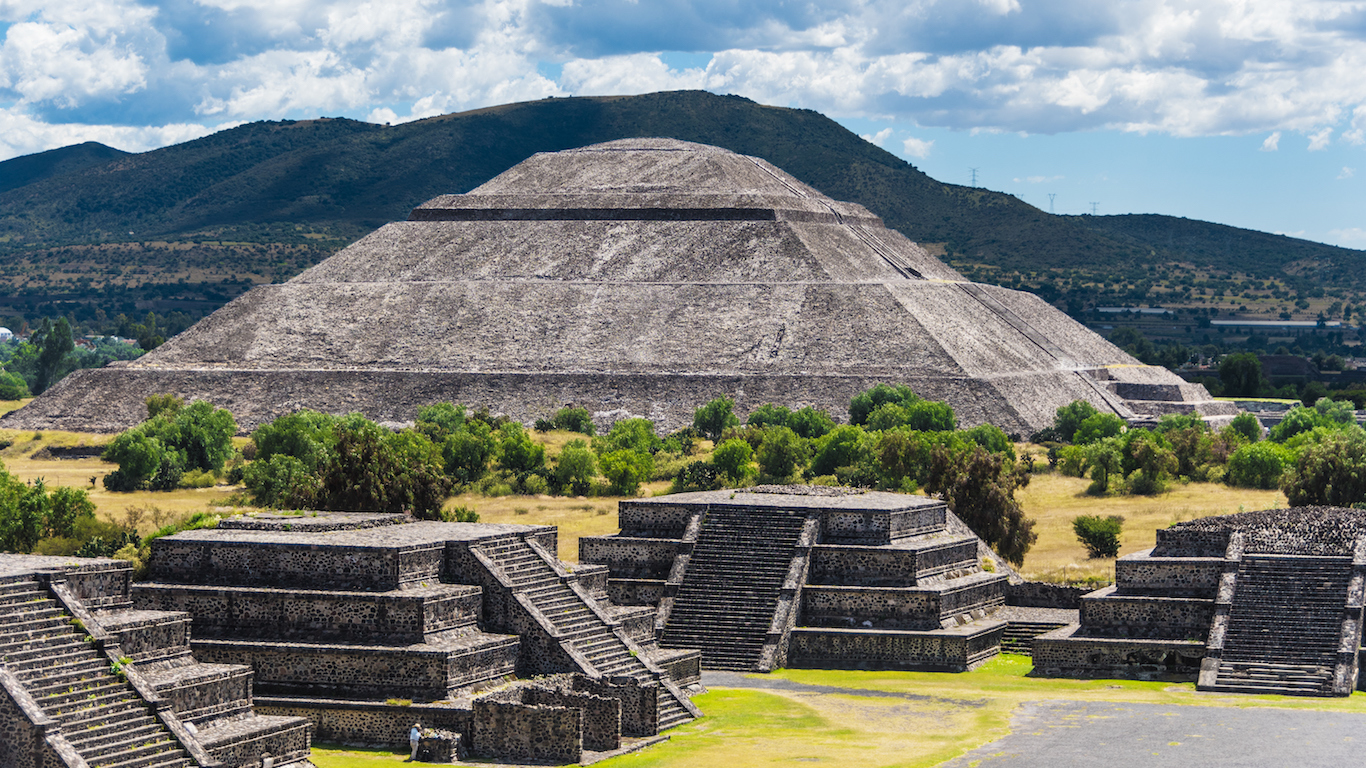
22. Teotihuacan
> Peak population: 150,000
> Peak population year(s): 800 B.C., A.D. 500
> Location 19.7° -98.8°, present day Mexico
Teotihuacan is an ancient Mesoamerican city located 30 miles northeast of present-day Mexico City. It was designated a UNESCO World Heritage Site in 1987. Teotihuacan was settled around 400 B.C. and 800 years later had become the most powerful city in the region. The city was laid out in a grid pattern about 8 square miles and featured pyramids, temples, and palaces, many of which remain intact. The city had been abandoned for centuries when the Aztecs found it in the 1400s and named it Teotihuacan, which means “the place where the gods were created.”
[in-text-ad]

21. Thebes
> Peak population: 150,000
> Peak population year(s): 1200 B.C.
> Location 25.7° 32.6°, present day Egypt
Once home to pharaohs, the subject of Greek myths, and today an UNESCO World Heritage Site and popular tourist destination, Thebes is one of the most famous ancient cities. According to data from the report “Spatializing 6,000 years of global urbanization from 3700 B.C. to A.D. 2000,” Thebes’ population of 80,000 in the year 1300 B.C. was the second largest in the world after the Chinese city of Yin at that time. One hundred years later, the population nearly doubled in size, making Thebes the likely largest city in the world. At its peak, the city, also known as Waset, was the center of the Egyptian Empire.

20. Athens
> Peak population: 155,000
> Peak population year(s): 430 B.C.
> Location 38.0° 23.7°, present day Greece
The population of ancient Athens peaked at approximately 155,000 in 430 B.C., at the end of the city’s all-too-brief period of peace from 454 B.C. to 430 B.C., between the Persian and Peloponnesian wars. According to historical records, the city’s population would not surpass this size until A.D. 1900, when Athens had around 181,000 inhabitants. Many of Western Civilization’s core ideas related to democracy, taxes, writing, and science are said to have originated in ancient Athens.
Athens was and is home to some of the Western world’s most treasured historical sites. UNESCO designated the Acropolis of Athens and its monuments — including the Parthenon, which was constructed in 438 B.C. in honor of the city’s patron goddess Athena — as a World Heritage site.
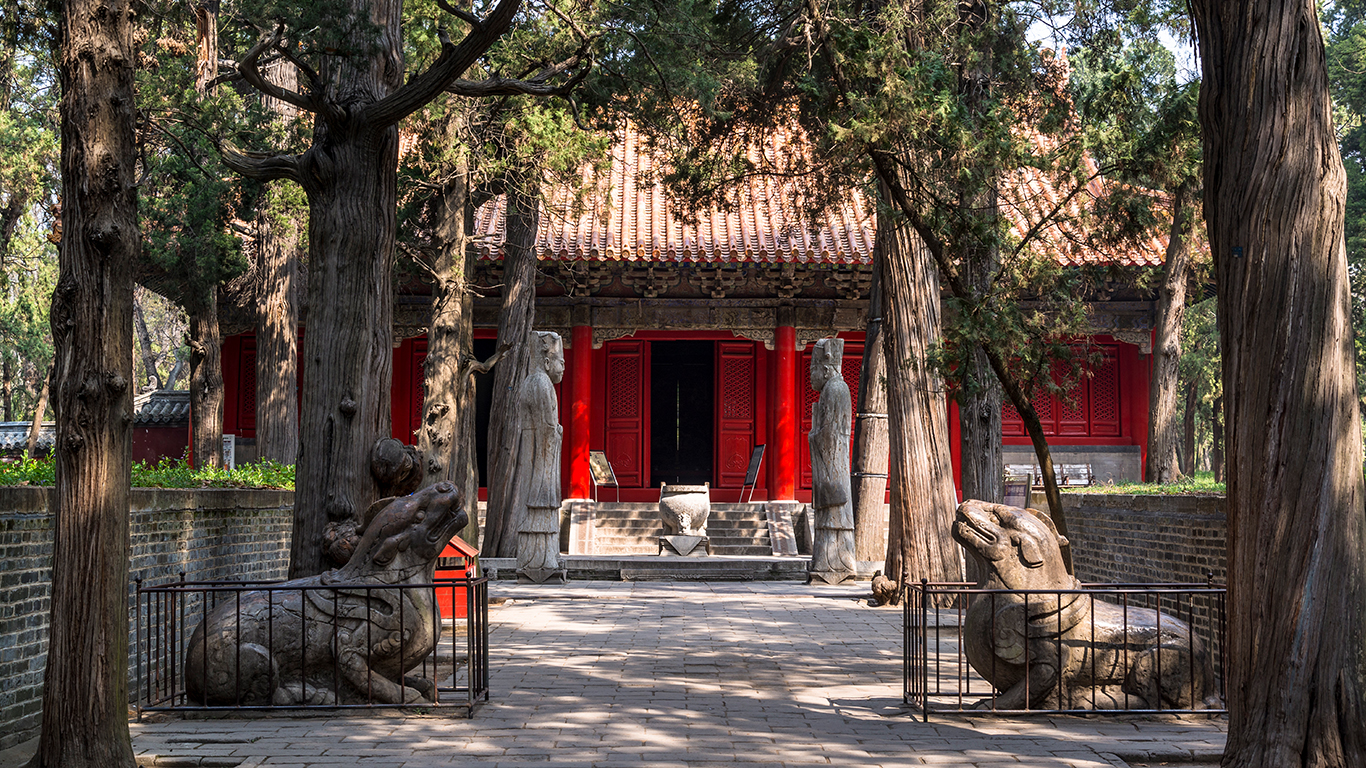
19. Qufu
> Peak population: 180,000
> Peak population year(s): 300 B.C.
> Location 35.6° 117.0°, present day China
Qufu, a two-hour ride from Beijing, has also been called Lu. The city in the Shandong province is best known as the hometown of the philosopher Confucius, who was born in 551 B.C. The city is also known for the Confucius Temple, built to honor the philosopher after his death in 479 B.C. The temple, which was built in 1724, sprawls over 50 acres.
[in-text-ad-2]

18. Datong
> Peak population: 200,000
> Peak population year(s): A.D. 500
> Location 40.1° 113.3°, present day China
Datong, also called Taitong or Tatung in ancient times, is located about 220 miles west of Beijing and just south of the Great Wall. Datong grew in importance after the Wei Dynasty gained control of northern China and established Datong as the capital at the end of the fourth century. The Wei royal family were devout Buddhists and as a result, Buddhist cave temples were built. Datong became a stronghold against Mongol invasions during the Ming Dynasty, which tried to establish a more centralized China.
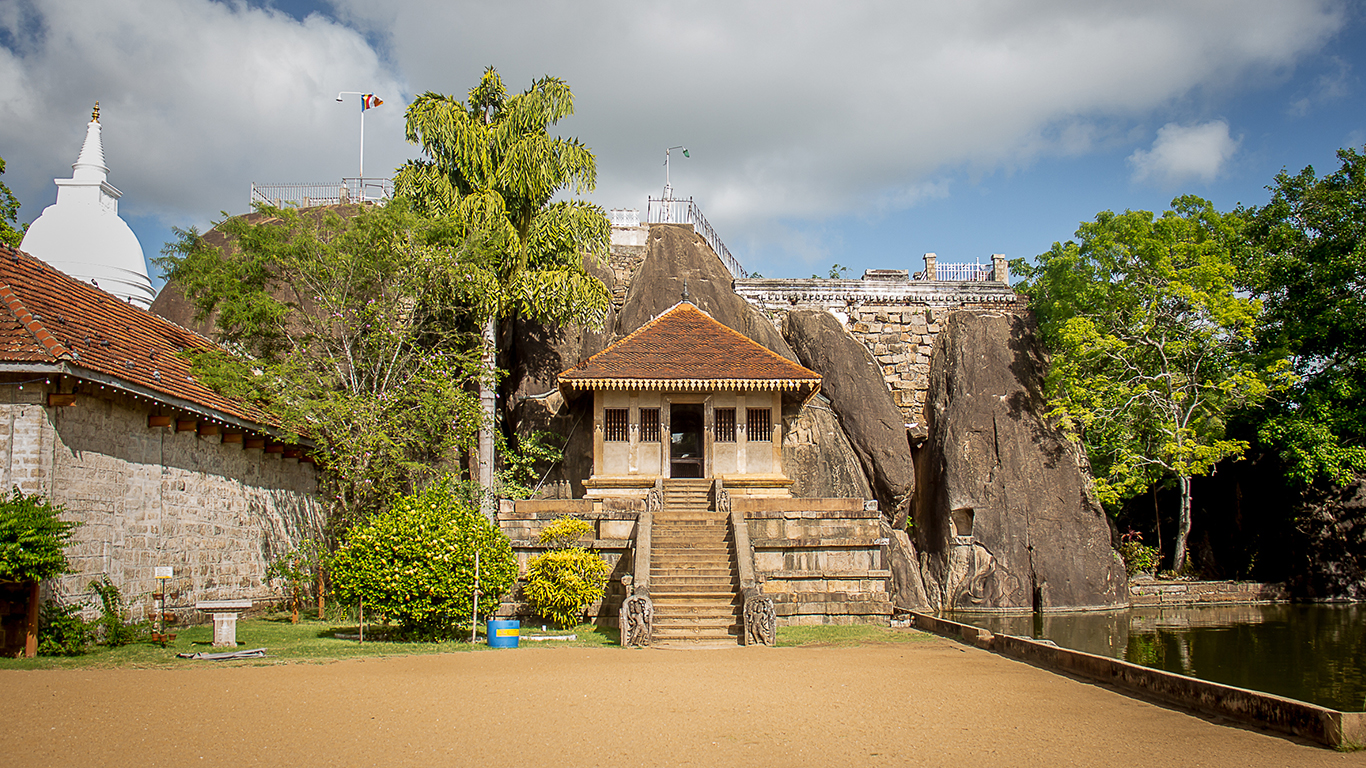
17. Anuradhapura
> Peak population: 200,000
> Peak population year(s): A.D. 100, A.D. 200
> Location 8.4° 80.4°, present day Sri Lanka
The origins of ancient Anuradhapura revolve around the planting of the “tree of enlightenment,” Buddha’s fig tree brought to the site in the third century B.C. by Buddhist nuns. The ruins of Anuradhapura are evidence of the Ceylonese political and religious capital that lasted for 1,300 years until it was abandoned after an invasion in A.D. 993. The ruins of the city had been hidden in the jungle for years. The remains of palaces, temples, and monuments can be found there.
[in-text-ad]
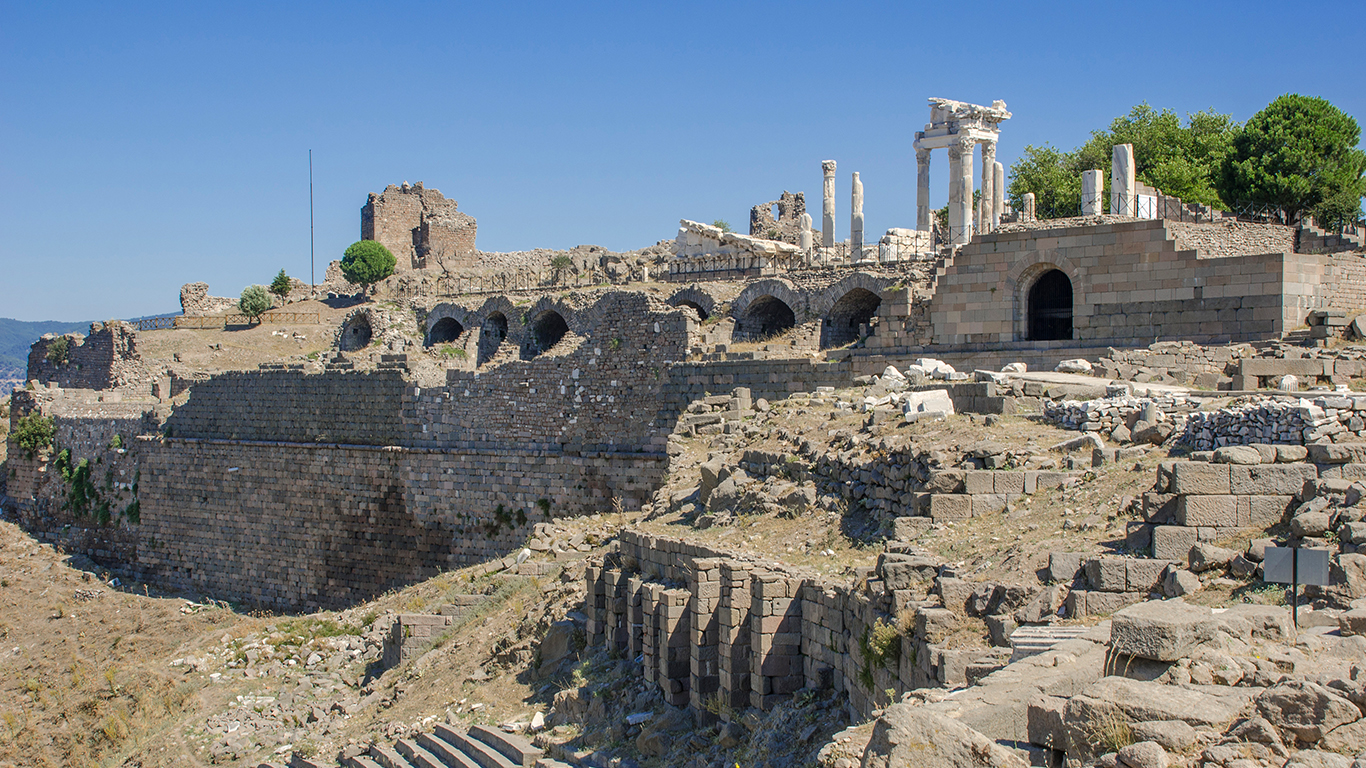
16. Pergamum
> Peak population: 200,000
> Peak population year(s): 200 B.C.
> Location 39.1° 27.2°, present day Turkey
Pergamum was located on a hill near the Caicus River in present-day Izmir in Turkey, and the site is known as Bergama today. Pergamum had existed since at least the fifth century B.C. and reached its peak in Hellenistic era in the fourth century B.C. The city created a library that apparently rivaled that of the legendary library of Alexandria. Parchment was said to have been developed there. Pergamum became a sophisticated city, and its population swelled to 200,000. Among the ancient Roman and Greek ruins are a 10,000-seat amphitheater, places of worship, and a racetrack.
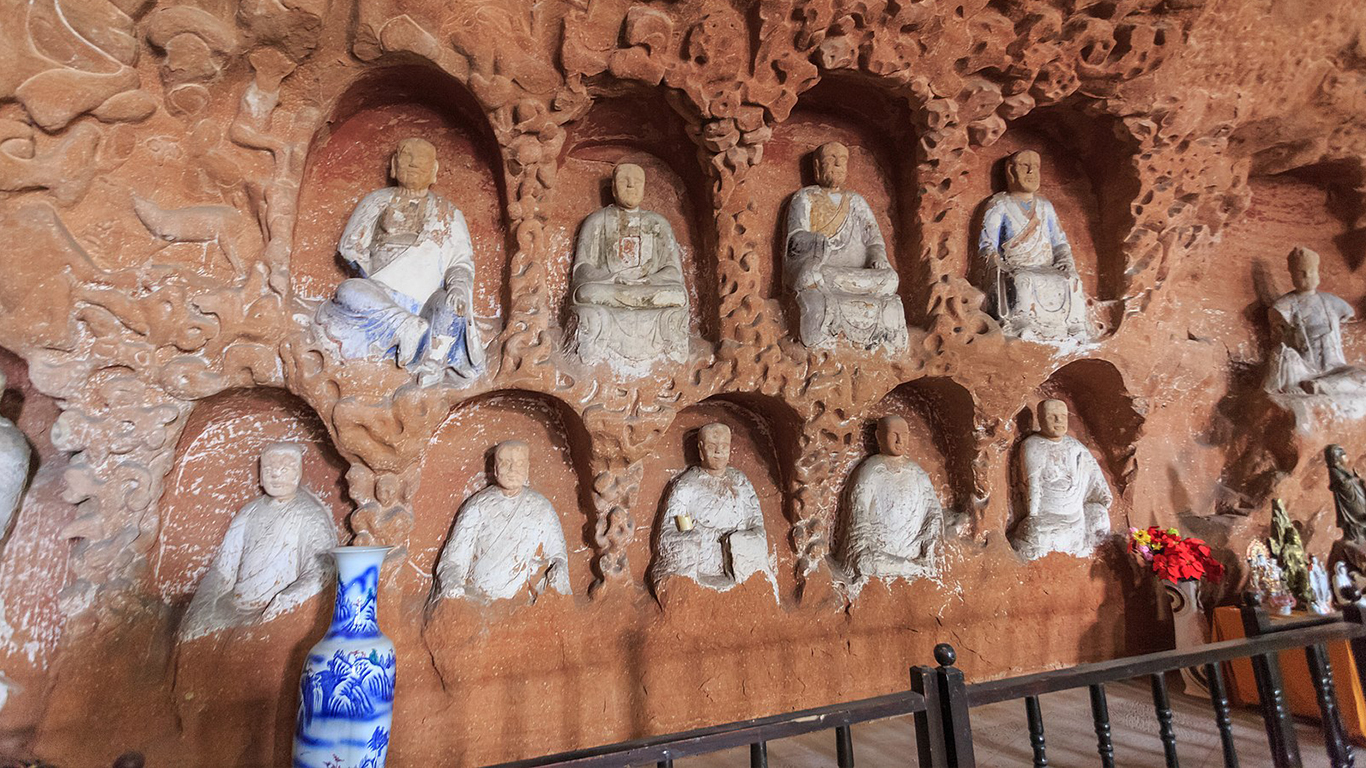
15. Yiyang
> Peak population: 200,000
> Peak population year(s): 300 B.C.
> Location 28.6° 112.3°, present day China
Yiyang, a city in southeast China near the Zi River, was established in the second century B.C. Yiyang relied on agriculture for its livelihood for much of its history. Its growth rested on the use of bamboo and it was known as “bamboo town” because of the various crafts that developed from bamboo.
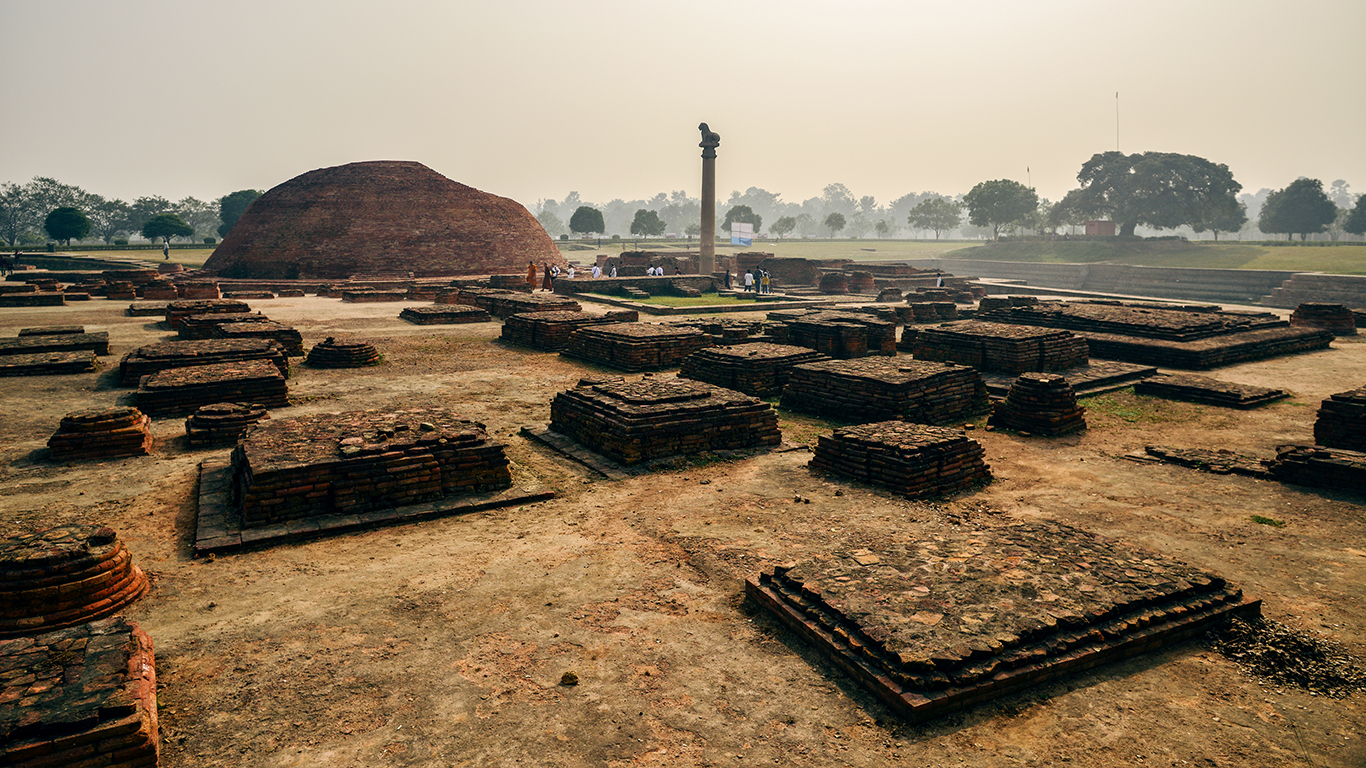
14. Vaishali
> Peak population: 200,000
> Peak population year(s): 300 B.C., A.D. 300
> Location 25.7° 85.1°, present day India
One of several cities in India on this list, the ancient city of Vaishali was the capital of the Licchavi Republic, who settled in present day northern India between the sixth and fifth centuries B.C. Buddha was allegedly a frequent visitor of the city, which would become an important location in the history of Buddhism and the ancient Indian religion Jainism. Vaishali was at any given point in antiquity the second largest city in India after Pataliputra.
[in-text-ad-2]
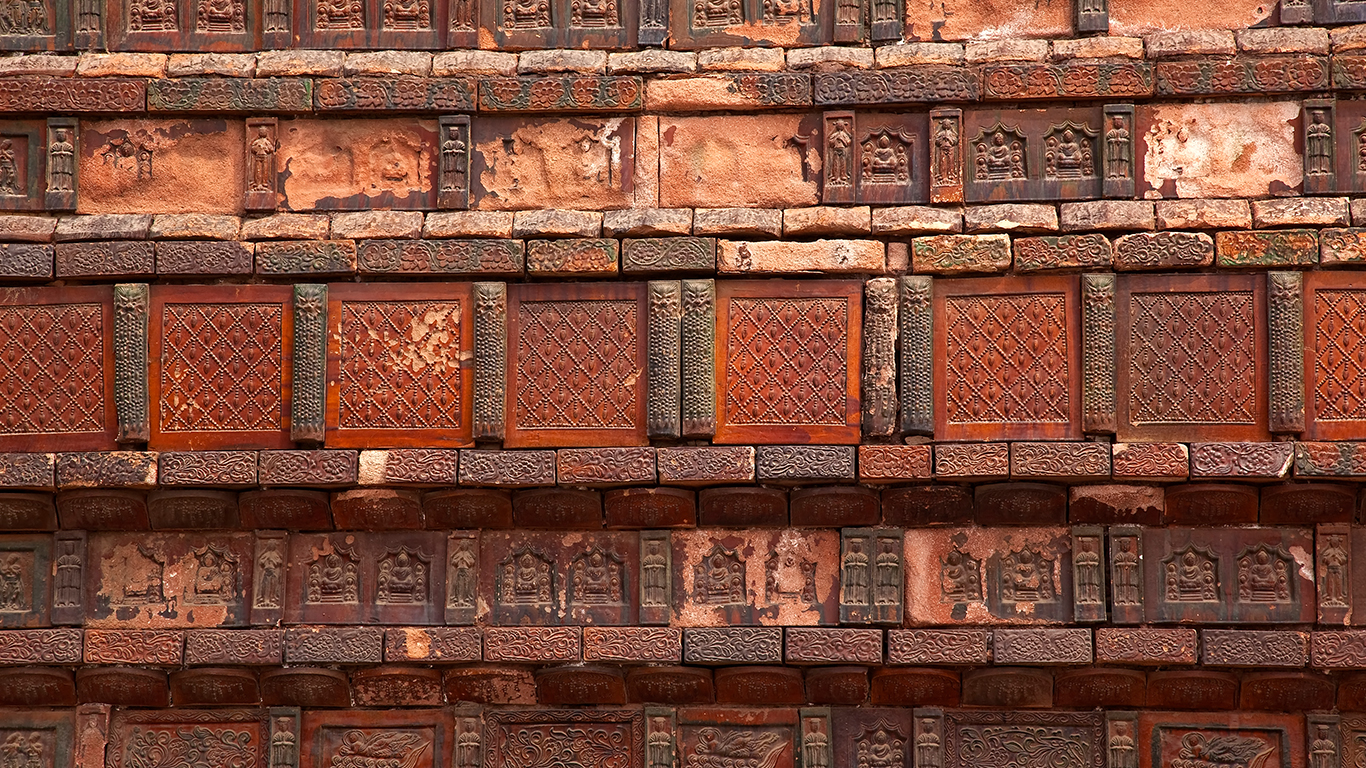
13. Kaifeng
> Peak population: 200,000
> Peak population year(s): 400 B.C.
> Location 34.8° 114.3°, present day China
Kaifeng, located about 400 miles south of Beijing in the eastern part of China, was the capital of the Wei state, one of the warring factions in China, which built many canals in the city in the fourth century B.C. Kaifeng’s importance grew during the Tang period beginning in A.D. 618, when it became a cosmopolitan center. Kaifeng also is known for its Jewish community. A stone tablet dated from 1512 that was discovered in Kaifeng claims Judaism came to China between 206 B.C. and A.D. 220. The oldest known synagogue in Kaifeng was constructed in A.D. 1163.
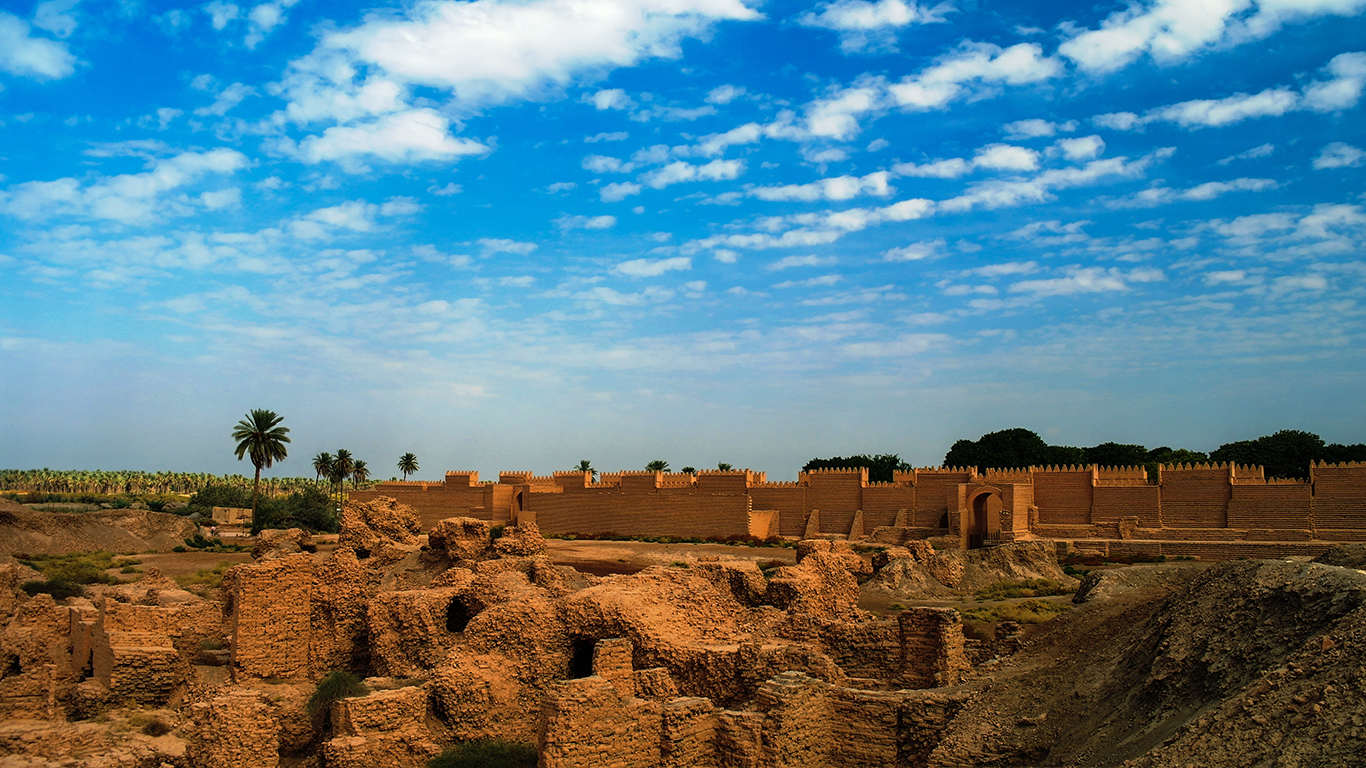
12. Babylon
> Peak population: 200,000
> Peak population year(s): 600-400 B.C.
> Location 32.5° 44.4°, present day Iraq
Home to the ziggurat Tower of Babel and the ancient wonder the Hanging Gardens, settled between the Tigris and Euphrates rivers just south of present day Baghdad, the lost ancient city of Babylon’s known history is as illustrious as might be expected of the birthplace of Western urban civilization.
According to the report, “Spatializing 6,000 years of global urbanization from 3700 BC to AD 2000,” Babylon’s population was as high as 200,000 in 600 B.C. — 1,000 years after its founding by Hammurabi and around the start of the reign of king Nebuchadnezzar II, under whose rule the city is said to have reached peak prosperity. The Greek geographer Strabo visiting the city around 7 B.C. wrote, “[The roadway upon the walls will allow chariots with four horses when they meet to pass each other with ease. Whence, among the seven wonders of the world, are reckoned this wall and the hanging garden: the shape of the garden is a square […] It consists of vaulted terraces, raised one above another, and resting upon cube-shaped pillars. These are hollow and filled with earth to allow trees of the largest size to be planted.”
[in-text-ad]
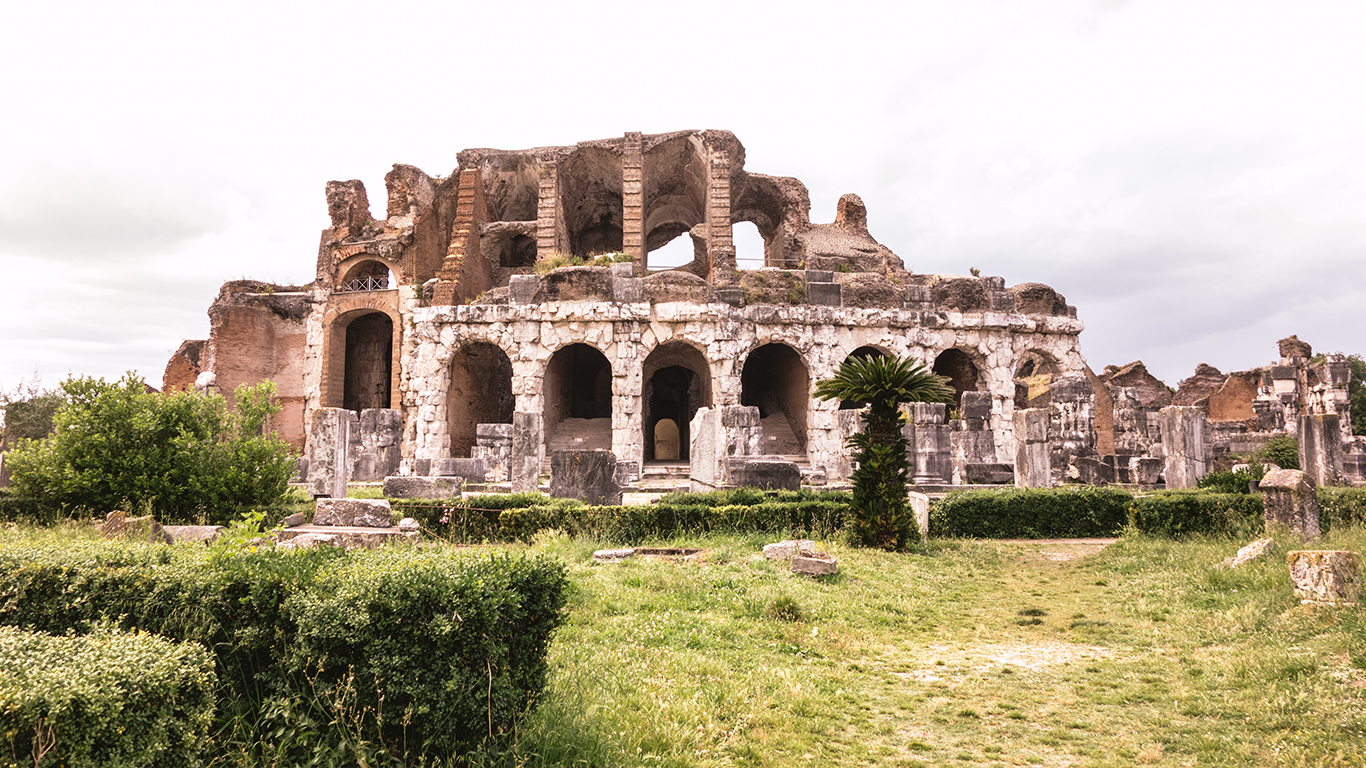
11. Capua
> Peak population: 240,000
> Peak population year(s): A.D. 200
> Location 41.1° 14.2°, present day Italy
Ancient Capua was one of the wealthiest and largest cities of the Roman Empire. Its significance was such that Roman statesman Cicero called it “the second Rome” because of its beauty and wealth. Capua, which was connected to Rome via the Appian Way, provided troops for the Punic Wars against Carthage. It was faithful to Rome until the empire’s disastrous military defeat at Cannae at the hands of Hannibal. Capua then switched sides to join Carthage. Rome eventually defeated Carthage and punished Capua, but the Capuans’ production of wine, spices, and manufacture of bronze objects kept them prosperous until the fall of Rome in the fifth century.
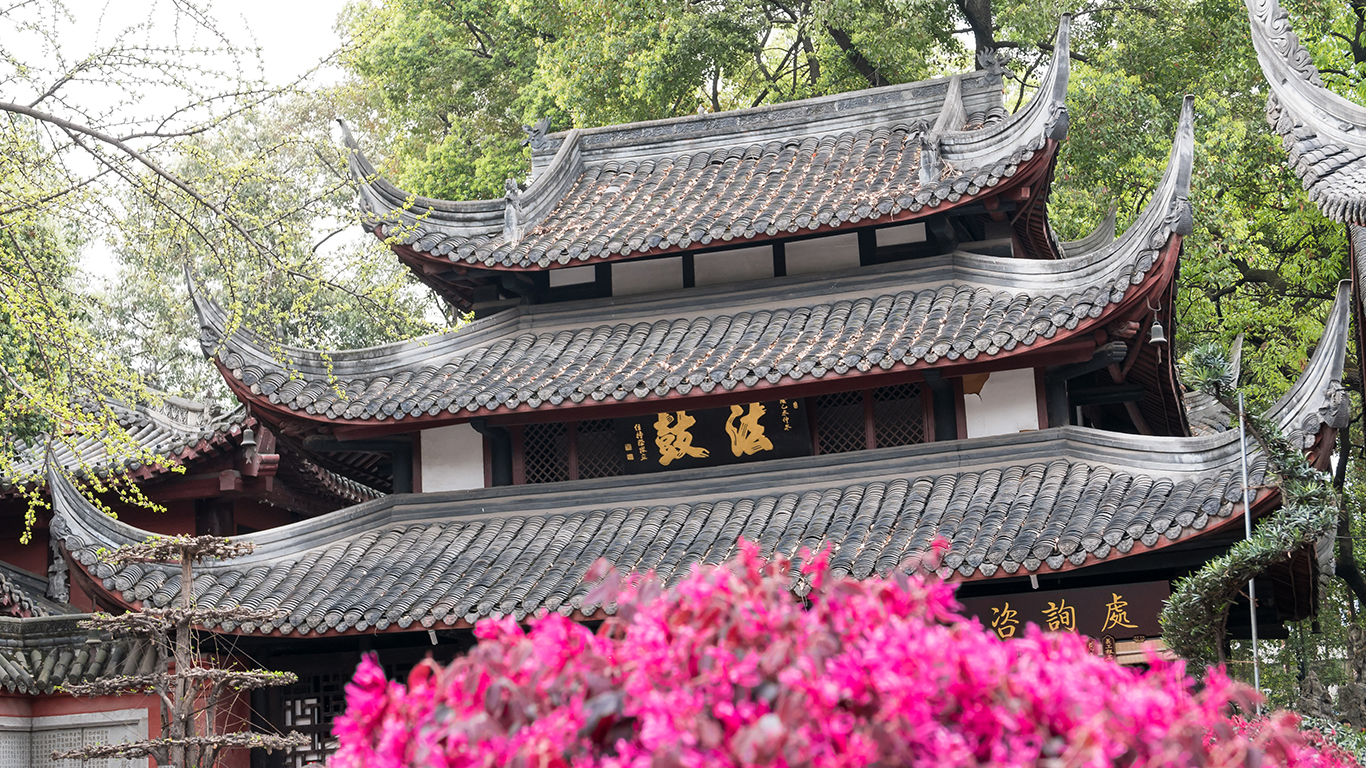
10. Chengdu
> Peak population: 250,000
> Peak population year(s): A.D. 1
> Location 30.7° 104.1°, present day China
Chengdu means “to become a city” and it has been one for more than 2,300 years. It is the only Chinese city that has not changed its name or location. An archaeological site accidentally discovered in 2001 yielded foundations for a palace, a burial area, and dwellings for common people from about 1200 B.C. to 650 B.C. Chengdu claims to be the place where the printing press was invented and where paper money was first circulated. Chengdu, located in central China, has become a destination for tourists because it is known for pandas, spicy food, and an LGBTQ-tolerant culture.
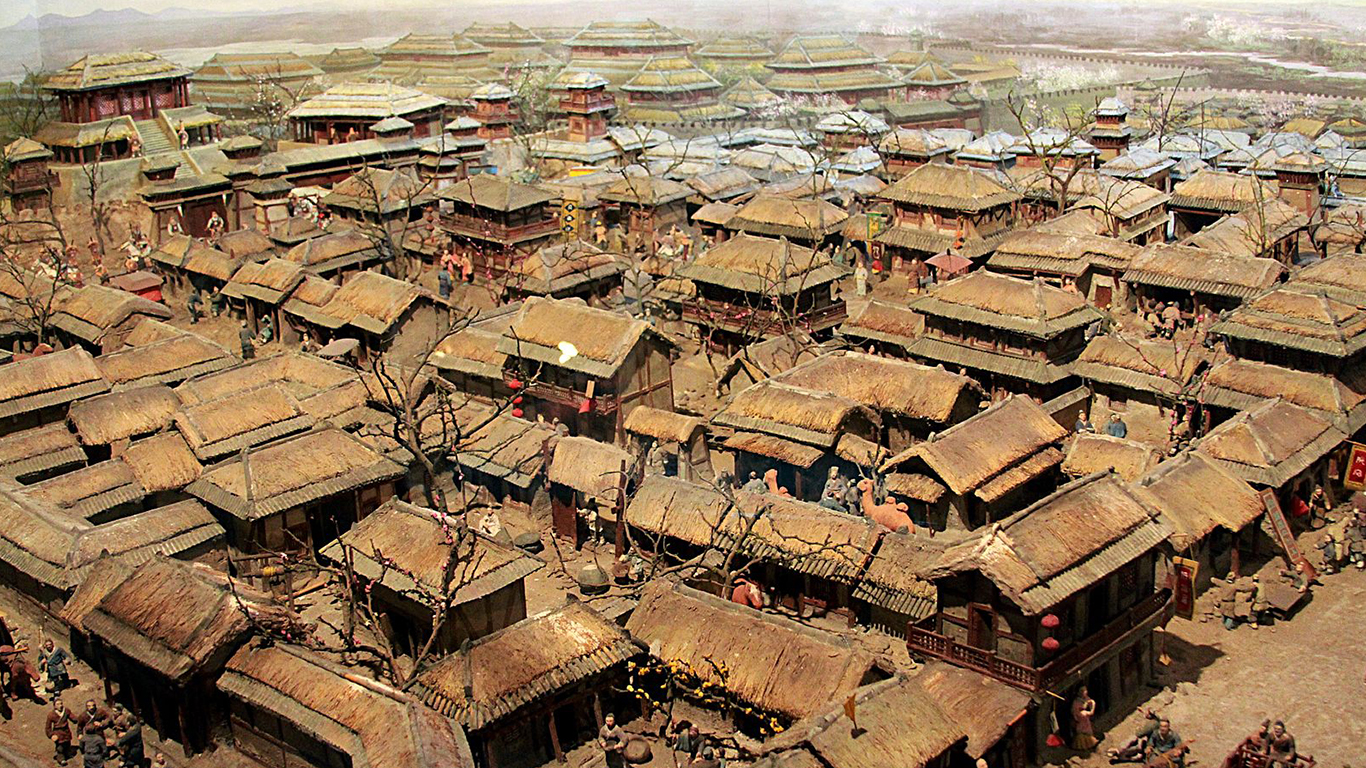
9. Linzi
> Peak population: 350,000
> Peak population year(s): 300 B.C.
> Location 36.8° 118.3°, present day China
Linzi is located in the eastern section of China in Shandong province near the Zi River. In 300 B.C., it was one of the largest cities in the world with 350,000 people and was the greatest city in China. Linzi was the capital of the state Qi, one of the most powerful feudal kingdoms in China, starting in 859 B.C. Linzi became the intellectual and cultural capital of eastern China. The city fell into ruin because of civil wars and invasions in the third and fourth centuries. Visitors to Linzi today can still see evidence of its former glory. Its existing city walls are from the sixth and seventh centuries. To the north of the city are the ruins of the ancient Qi capital.
[in-text-ad-2]
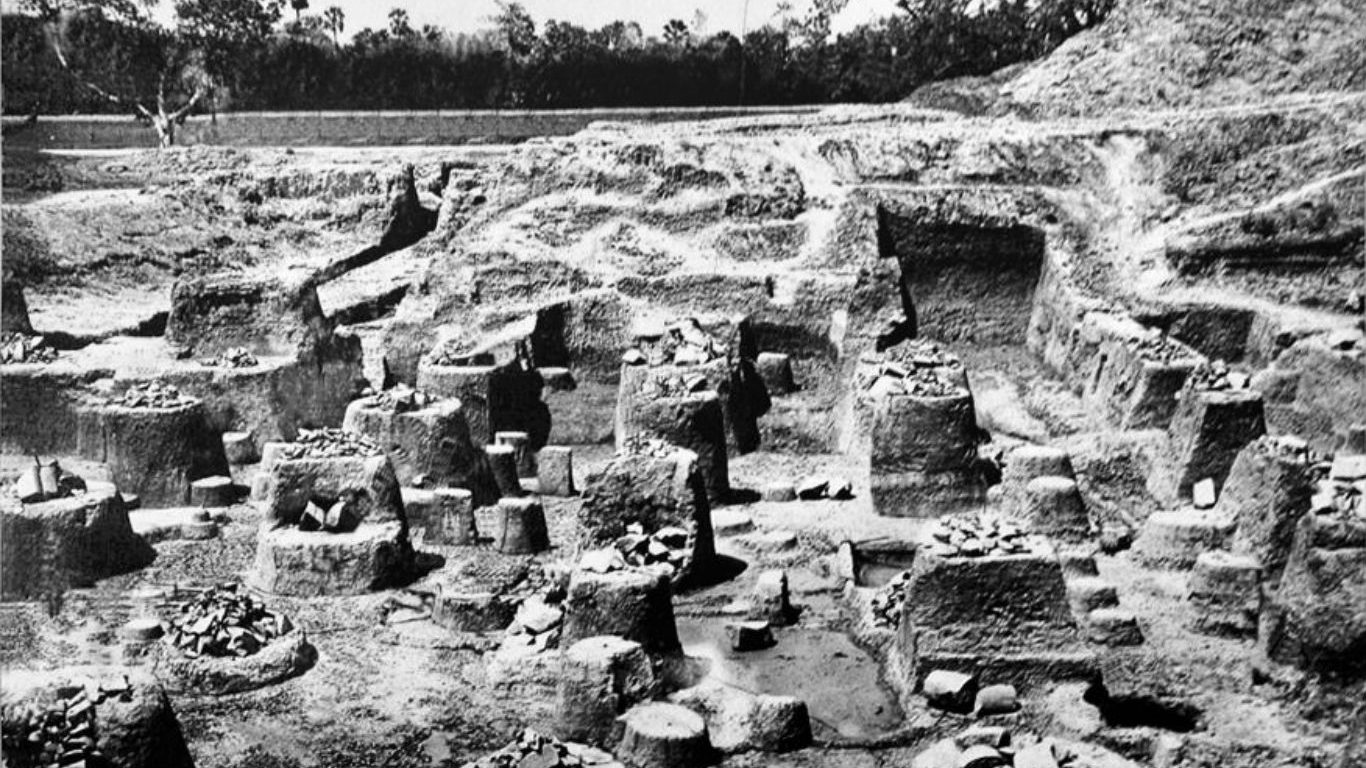
8. Pataliputra
> Peak population: 400,000
> Peak population year(s): 300 B.C.
> Location 25.6° 85.1°, present day India
Pataliputra, located in northern India just south of the Ganges River, was a major city in 300 B.C., with 400,000 people. It is one of the oldest cities in India, founded in the fifth century B.C. It reached its apex in the fourth century A.D. as a center of learning but declined and was deserted three centuries later. An Afghan ruler re-founded the city in 1541 as Patna, and the city returned to prosperity. The British took over Patna in 1765.
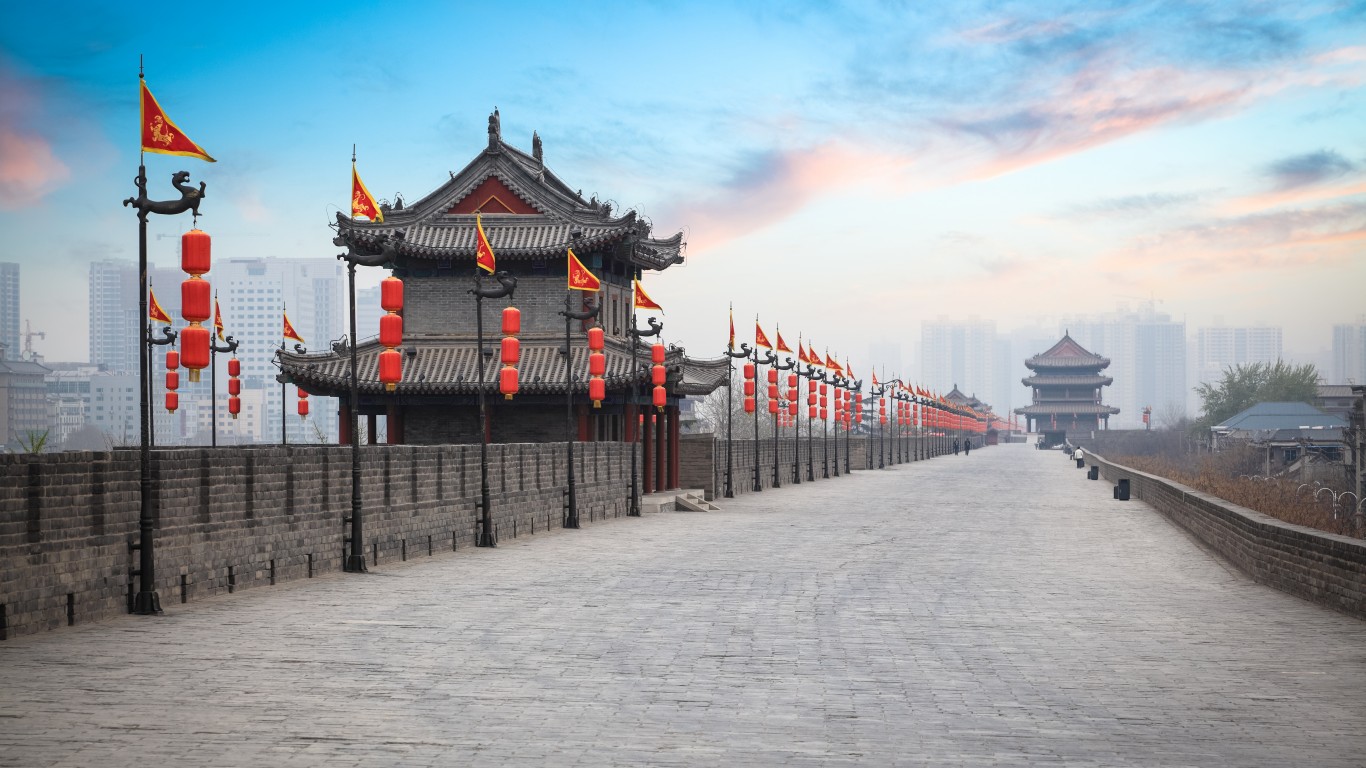
7. Xi’an
> Peak population: 420,000
> Peak population year(s): A.D. 1
> Location 34.3° 108.9°, present day China
Xi’an, also known as Sian or Chang’an was the second largest city in the world in A.D. 1 after Rome. Xi’an, founded 3,000 years ago in central China, was the eastern terminus of the famed Silk Road trade route. The city was an imperial capital to 10 dynasties. Xi’an’s golden age was during the Tang Dynasty (A.D. 618-907), and it became as significant in the East as Rome was in the West. Xi’an was built in a symmetrical pattern and became a model for city design. When the Tang Dynasty fell, Xi’an was no longer the capital and began to decline. The world would be reminded of Xi’an’s former glory in 1974, when workers digging a well near Xi’an discovered what would be called the terracotta army protecting Qin Shi Huang, the first emperor of China, in the afterlife.
[in-text-ad]
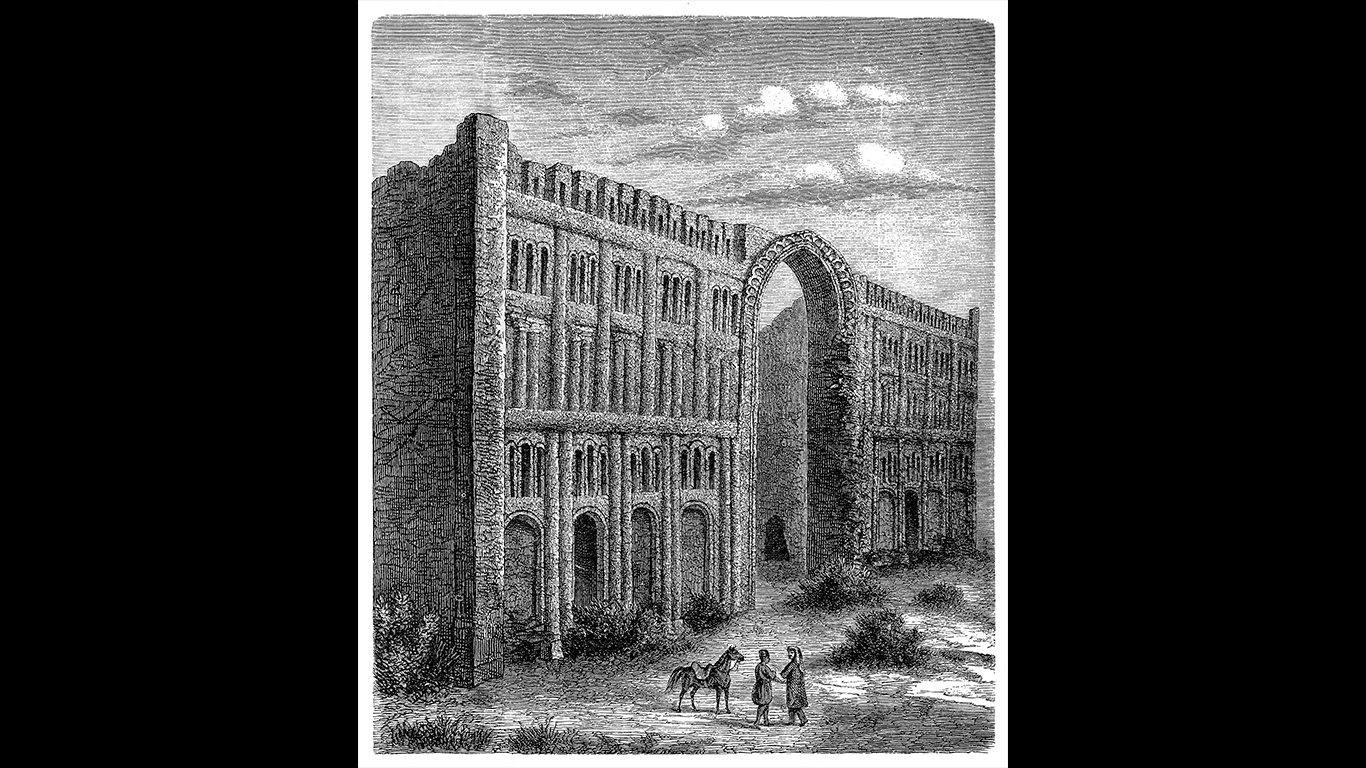
6. Ctesiphon
> Peak population: 500,000
> Peak population year(s): A.D. 600, A.D. 622
> Location 33.1° 44.6°, present day Iraq
Ctesiphon, also known as Taq-I Kisra, was located on the left bank of the Tigris River, 20 miles southeast of present-day Baghdad. It was the second-largest city in the world in A.D. 600, with a population of 500,000, based on data from the report “Historical Urban Population: 3700 BC-AD 2000.” Ctesiphon was the winter capital of the Parthian Empire and later of the Sāsānian Empire. The city’s site is renowned for the remains of a massive vaulted hall called the Ṭāq Kisrā that is believed to be the remains of the palace of the Sāsānian king Khosrow I who lived in the sixth century. Ctesiphon’s importance declined after it was sacked by the Romans and the Arabs, and later after it was surpassed by the newly built Baghdad. The city’s ruins were used as a quarry for building materials.

5. Nanjing
> Peak population: 500,000
> Peak population year(s): A.D. 500
> Location 32.0° 118.8°, present day China
Nanjing, also known today as Nanking, was the world’s largest city in the year A.D. 500 with 500,000 people, along with Constantinople and Luoyang, based on data from the report “Historical Urban Population: 3700 BC-AD 2000.” Nanjing was one of the four ancient capitals of China along with Beijing, Xi’an, and Luoyang. Nanjing’s importance was due to its key position on the Yangtze River.
The city served as the capital of 10 Chinese dynasties over an 1800-year period. Nanjing began its rise to prominence during the Three Kingdoms era (A.D. 220–280). Sun Quan, founder of the Eastern Wu Dynasty, shifted his court to Nanjing and presided over a dramatic increase in trade and prosperity for the city. Nanjing reached its peak in the mid-sixth century, as it benefited from migration of craftsmen and artists fleeing the violence in the north. Nanjing became capital for all of China during the Ming Dynasty, before the capital was moved to Beijing.
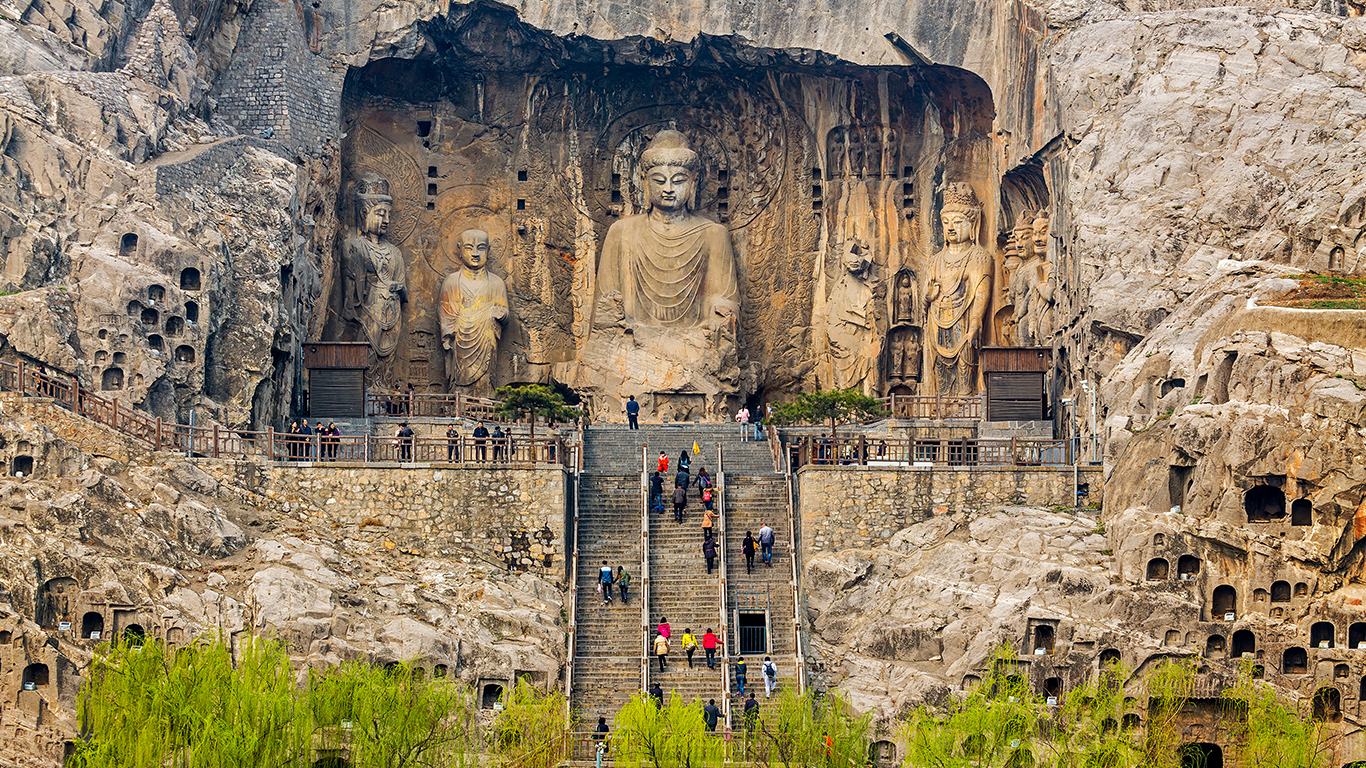
4. Luoyang
> Peak population: 500,000
> Peak population year(s): A.D. 500, A.D. 600
> Location 34.7° 112.4°, present day China
Luoyang, also known today as Honan, is situated where the Luo and Yi rivers meet in the Henan province of eastern-central China. Luoyang vied with Xi’an to be China’s capital city. Luoyang was a particularly important city when it was capital during the latter stages of the Han Dynasty (206 B.C.-A.D. 220). The city was surrounded by high walls and 12 gates and would be eventually laid out in a grid pattern. Luoyang developed a rich cultural tradition, and was especially noted for its Confucian literature. Luoyang also was a trading mecca, receiving goods from across the Chinese Empire, Japan, and central Asia. But Luoyang suffered repeated sackings as dynasties switched capital cities and the city fell into ruin by the third century.
[in-text-ad-2]
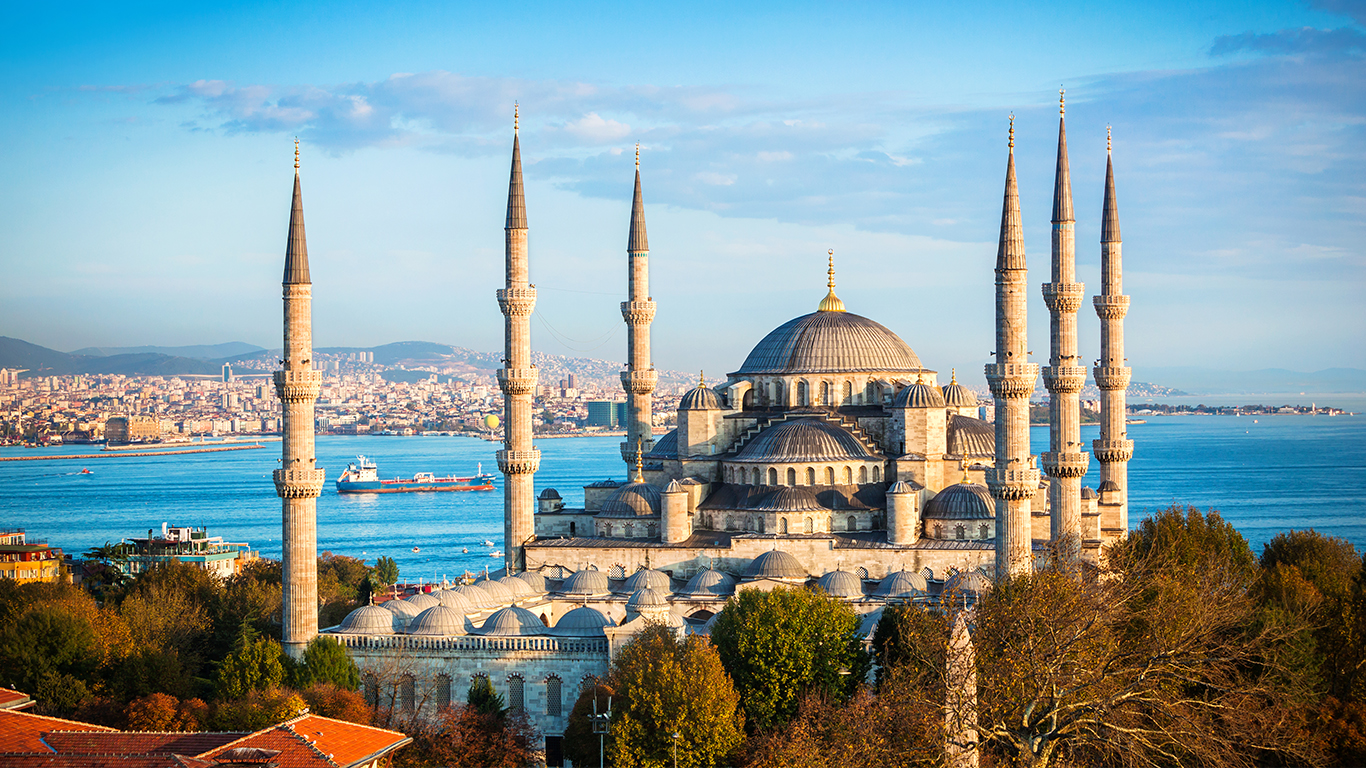
3. Istanbul
> Peak population: 600,000
> Peak population year(s): A.D. 600
> Location 41.0° 29.0°, present day Turkey
Unlike many of antiquity’s oldest and largest population centers, Istanbul is still one of the world’s major cities, although little to no original structures remain of the ancient city. Over its long history, numerous fires, earthquakes, and invasions devastated and reshaped Istanbul. More than 60 destructive fires were considered important enough to include in the historical record, and recent seismic research has revealed there was over a period of thousands of years regular severe earthquakes in the region. The city changed hands many times, most notably after the invasion of Constantine the Great.
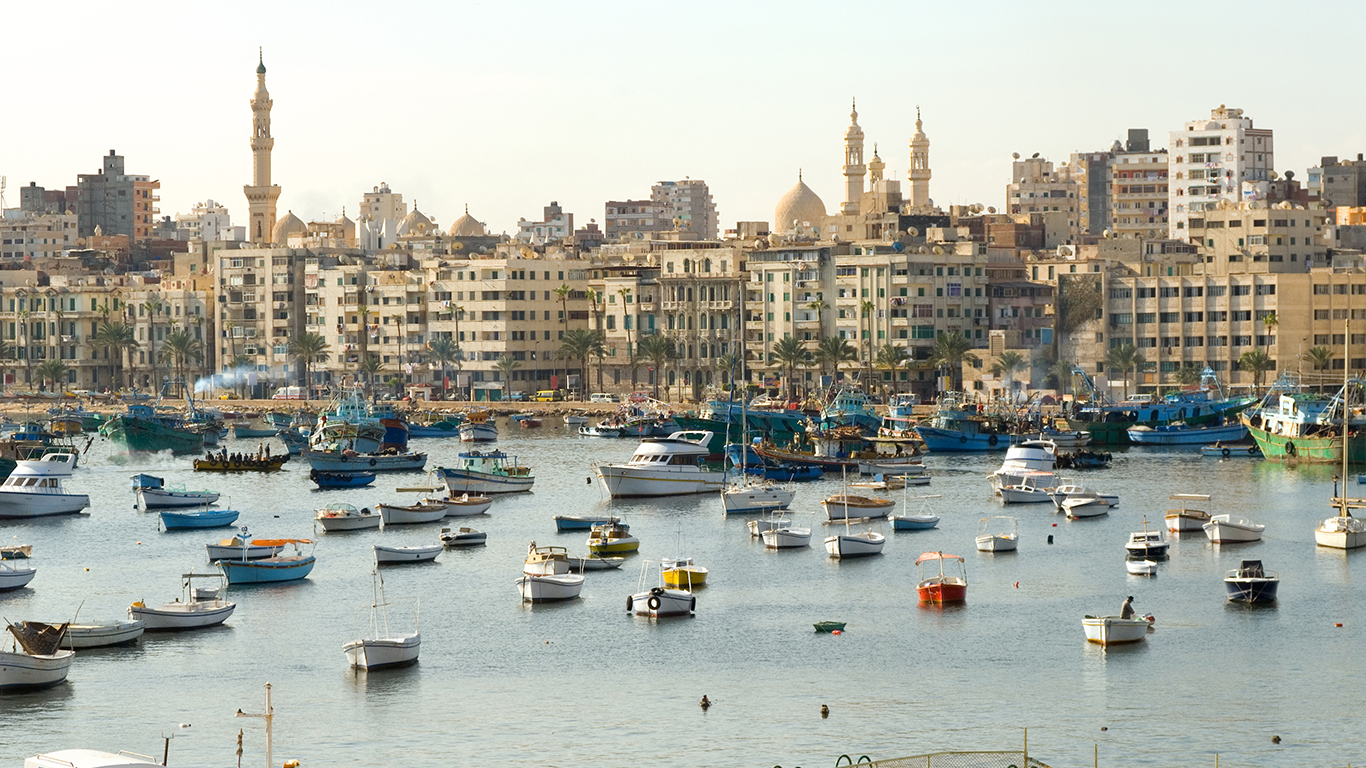
2. Alexandria
> Peak population: 1,000,000
> Peak population year(s): 100 B.C.
> Location 31.2° 29.9°, present day Egypt
Ancient Alexandria’s peak population of 1 million people in 100 B.C. was just shy of the city’s population in 1950. Founded in 332 B.C. by Alexander the Great, Alexandria was consistently one of the ancient world’s largest and most marvelous cities.
Among Alexandria’s cultural and architectural wonders were the Library and the Lighthouse of Alexandria. The library, which served as an invaluable resource for scholars and researchers in ancient times, was burned during the invasion by Julius Caesar in 48 B.C. The lighthouse, a 350-foot-tall tower on the island of Pharos, was likely the second tallest manmade structure in the world at that time after the pyramids of Giza.
[in-text-ad]
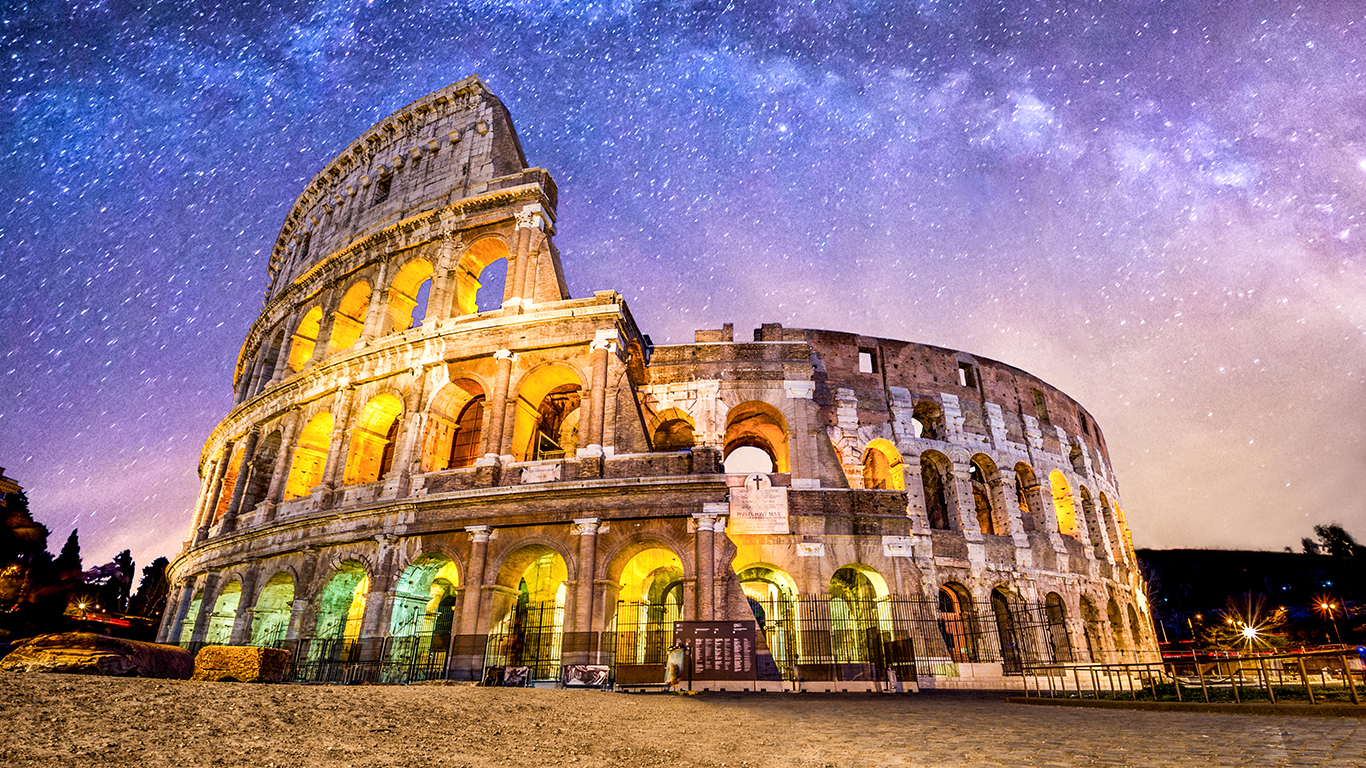
1. Rome
> Peak population: 1,200,000
> Peak population year(s): A.D. 200
> Location 41.9° 12.5°, present day Italy
Rome was of course the most important city of the ancient world — and the most populous. Rome developed from a small town on the banks of the Tiber River in what is now central Italy into the ancient world’s greatest empire. Whether it was as a republic or an empire, Rome has helped define the modern world through its laws, city planning, architecture, system of government, military organization, creation of Romance languages, and literature. When the empire fell in the fifth century, it created a power vacuum that would not be filled until the founding of the Holy Roman Empire hundreds of years later.
Detailed findings & methodology:
Data obtained from this report has provided a more comprehensive understanding of ancient cities, how they were created, what industries flourished, the role geography played in their development, what contributed to their rise and demise, and how many people lived in them.
Based on this data, 13 of the 42 megacities of the ancient world are located in today’s China. Many of these cities served as capital of ancient China at one time or another. Qufu, one of the Chinese cities on the list, was the birthplace of the philosopher Confucius.
The rest of this list is more diffused, though no less interesting. Today’s Turkey has four cities on our list, including not surprisingly, Istanbul — known variously as Byzantium, Constantinople, and Stamboul. Less known is Pergamum, where the city of Bergama is today. Ancient Pergamum built a library that is said to have rivaled that of the legendary library of Alexandria. Parchment is said to have been created in Pergamum.
What are now India, Iraq, and Italy each have three cities on the list, and the histories of many of those ancient cities were defined by their proximity to major rivers. Pataliputra, located in northern India, developed near the Ganges River, and by 300 B.C., it had 400,000 people. In Iraq, the renowned city of Ur, which dates back from 4000 B.C., became important because it was located where the Tigris and Euphrates rivers pour into the Persian Gulf. Rome’s glory began on the banks of the Tiber River.
The famed Silk Road, the main trading artery in central Asia that connected China with the West, played a vital role in the development of cities such as Samarkand, Merv, and Xi’an.
No list of ancient cities would be complete without the inclusion of Egyptian cities Alexandria and Thebes. Alexandria is one of two cities on this list with a population estimated at 1 million people in ancient times. Thebes, whose population was 150,000 in 1200 B.C., was the center of of Egyptian civilization at its peak.
Three cities in the Western Hemisphere made the list in what are today Mexico, Bolivia, and Guatemala. The remains of those great cities from antiquity — Teotihuacan, Tiahuanaco, and Tikal — underscore the sophistication of the Aztec, Mayan, and pre-Columbian civilizations.
Advances in technology used for archaeological discovery have brought us closer to ancient times and civilizations, and to the understanding of how our world was made possible by the development of these great cities.
24/7 Wall St. reviewed the February 2018 data set created by NASA Socioeconomic Data and Applications Center (SEDAC) “Historical Urban Population, 3700 BC – AD 2000,” originally developed by the Yale School of Forestry & Environmental Studies. Authors Reba, M. L., F. Reitsma, and K. C. Seto estimated city populations from 3,700 B.C. through A.D. 2000 for cities around the world by digitizing, transcribing, and geocoding historical, archaeological, and census-based urban population data. City names, latitude, longitude, year, population, and a reliability ranking to assess the geographic uncertainty of each data point were included in the data set.
We compared from 3700 B.C. to the 5th and 6th centuries (the end of Roman rule in the Mediterranean, widely used to mark the end of the ancient period) each city with a peak population of 100,000 or greater. To be considered, each city’s population reliability ranking needed to be 1.
Retirement can be daunting, but it doesn’t need to be.
Imagine having an expert in your corner to help you with your financial goals. Someone to help you determine if you’re ahead, behind, or right on track. With SmartAsset, that’s not just a dream—it’s reality. This free tool connects you with pre-screened financial advisors who work in your best interests. It’s quick, it’s easy, so take the leap today and start planning smarter!
Don’t waste another minute; get started right here and help your retirement dreams become a retirement reality.
Thank you for reading! Have some feedback for us?
Contact the 24/7 Wall St. editorial team.